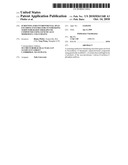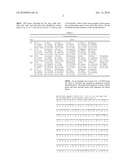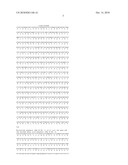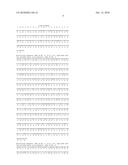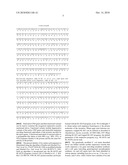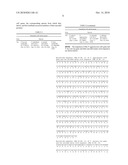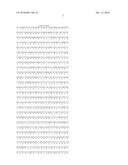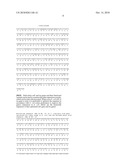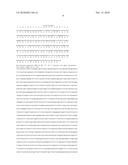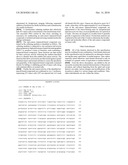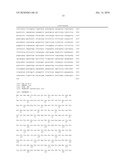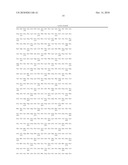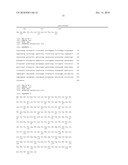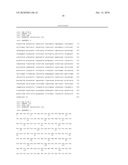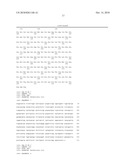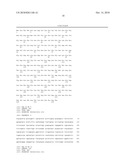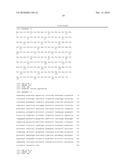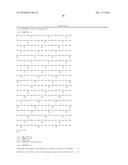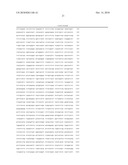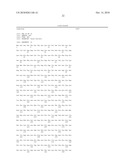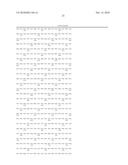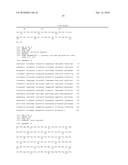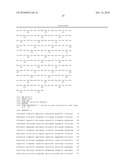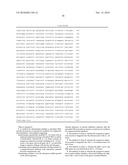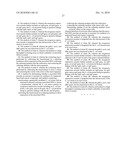Patent application title: Screening for Environmental DNAs Encoding Enzymes for Synthesizing Terpenoid-Based Therapeutic Compounds Using Genetically Modified E. Coli Strains
Inventors:
Blaine Pfeifer (Somerville, MA, US)
Yong Wang (Shanghai, CN)
IPC8 Class: AC12Q168FI
USPC Class:
435 6
Class name: Chemistry: molecular biology and microbiology measuring or testing process involving enzymes or micro-organisms; composition or test strip therefore; processes of forming such composition or test strip involving nucleic acid
Publication date: 2010-10-14
Patent application number: 20100261168
Claims:
1. A method for determining whether a microbial DNA encodes an enzyme or
enzymes for synthesis of a terpenoid-based antibiotic, said method
comprisingtransforming a genetically modified E. coli strain with an
expression plasmid carrying a microbial DNA to obtain a transformant,
wherein the E. coli strain contains an exogenous expression cassette
including an E. coli promoter, a dxs gene, and an idi gene, the E. coli
promoter being in operative linkage with the dxs and idi genes,contacting
a microorganism suspected of being sensitive to a terpenoid-based
antibiotic with substances released from the transformant, anddetermining
whether or not the substances inhibit growth of the microorganism,wherein
detection of growth inhibition indicates that the microbial DNA encodes
an enzyme or enzymes for synthesis of a terpenoid-based antibiotic.
2. The method of claim 1, wherein the exogenous expression cassette is integrated into the chromosome of the E. coli strain.
3. The method of claim 2, wherein the exogenous expression cassette is integrated into the E. coli chromosome at its araA locus.
4. The method of claim 1, wherein the gdhA, aceA, and fdhF genes are non-functional in the E. coli strain.
5. The method of claim 1, wherein the exogenous expression cassette further includes a ribosomal binding site adjacent to the 5' end of each of the genes contained therein.
6. The method of claim 1, wherein the exogenous expression cassette further includes an ispB gene, an ispD gene, or an ispF gene, the E. coli promoter being in operative linkage with the ispB, ispD, or ispF genes.
7. The method of claim 1, wherein the exogenous expression cassette further includes an ispB gene, an ispD gene, and an ispF gene, the E. coli promoter being in operative linkage with the ispB, ispD, and ispF genes.
8. The method of claim 7, wherein the exogenous expression cassette is integrated into the chromosome of the E. coli strain at its araA locus.
9. The method of claim 8, wherein the gdhA, aceA, and fdhF genes are non-functional in the E. coli strain.
10. The method of claim 1, wherein said method is a high throughput screening assay in which a plurality of microbial DNAs is tested.
11. The method of claim 1, wherein the contacting step is performed by cultivating the transformant in a culturing medium to allow expression of the microbial DNA, collecting the culturing medium after the cultivation, and contacting the culturing medium with the microorganism.
12. The method of claim 1, wherein the contacting step is performed by cultivating the transformant to form a colony and contacting the colony with a lawn of the microorganism.
13. A method for determining whether a microbial DNA encodes an enzyme or enzymes for synthesis of a terpenoid-based anti-cancer compound, said method comprisingtransforming a genetically modified E. coli strain with an expression plasmid carrying a microbial DNA to obtain a transformant, wherein the E. coli strain contains an exogenous expression cassette including an E. coli promoter, a dxs gene, and an idi gene, the E. coli promoter being in operative linkage with the dxs and idi genes,cultivating the transformant in a culturing medium to allow expression of the microbial DNA,collecting the culturing medium after the cultivation,contacting the culturing medium with cancer cells, anddetermining whether or not the culturing medium exerts cytotoxic effect on the cancer cells,wherein detection of cytotoxic effect indicates that the microbial DNA encodes an enzyme or enzymes for synthesis of a terpenoid-based anti-cancer compound.
14. The method of claim 13, wherein the exogenous expression cassette is integrated into the chromosome of the E. coli strain.
15. The method of claim 14, wherein the exogenous expression cassette is integrated into the E. coli chromosome at its araA locus.
16. The method of claim 13, wherein the gdhA, aceA, and fdhF genes are non-functional in the E. coli strain.
17. The method of claim 13, wherein the exogenous expression cassette further includes a ribosomal binding site adjacent to the 5' end of each of the genes contained therein.
18. The method of claim 13, wherein the exogenous expression cassette further includes an ispB gene, an ispD gene, or an ispF gene, the E. coli promoter being in operative linkage with the ispB, ispD, or ispF genes.
19. The method of claim 13, wherein the exogenous expression cassette further includes an ispB gene, an ispD gene, and an ispF gene, the E. coli promoter being in operative linkage with the ispB, ispD, and ispF genes.
20. The method of claim 19, wherein the exogenous expression cassette is integrated into the chromosome of the E. coli strain at its araA locus.
21. The method of claim 20, wherein the gdhA, aceA, and fdhF genes are non-functional in the E. coli strain.
22. The method of claim 13, wherein said method is a high throughput screening assay in which a plurality of microbial DNAs is tested.
Description:
BACKGROUND OF THE INVENTION
[0002]Many environmental microbes produce therapeutically effective terpenoid-based compounds, i.e., compounds synthesized from terpenoid compounds. They carry genes encoding enzymes that convert terpenoid compounds, i.e., products of the non-mevalonate 1-deoxy-D-xylulose-5-phosphate (DXP) pathway, to terpenoid-based compounds of interest. In general, it is not feasible to directly isolate these genes from the microbes, most of which cannot be cultured.
[0003]To isolate these genes of interest, one possible way is to introduce DNAs of environmental microbes into a culturable host and cells of the host are then screened for those that secret therapeutically effective terpenoid-based compounds. While E. coli is an ideal host, native E. coli strains produce low levels of terpenoid compounds to be converted to therapeutic terpenoid-based compounds due to poor expression of the genes involved in the DXP pathway.
SUMMARY OF THE INVENTION
[0004]The present invention features a method of screening for microbial DNAs that encode an enzyme or enzymes involved in the synthesis of a therapeutically effective terpenoid-based compound using a genetically modified E. coli strain that expresses high levels of terpenoid compounds, the products of the DXP pathway.
[0005]In one example, this method includes the following steps: (1) transforming the genetically modified E. coli strain with an expression plasmid containing a microbial DNA to obtain a transformant, (2) contacting substances released from the transformant with a tester microorganism suspected of being sensitive to a terpenoid-based antibiotic, and (3) determining whether or not the substances inhibits growth of the tester microorganism. Growth inhibition indicates that the microbial DNA encodes an enzyme or enzymes for synthesis of a terpenoid-based antibiotic (e.g., an anti-bacterial or anti-fungal compound). The contacting step can be performed by cultivating the transformant in a culturing medium to allow expression of the microbial DNA, collecting the culturing medium after cultivation, and contacting the culturing medium with the tester microorganism. Alternatively, this step is performed by cultivating the transformant to form a colony on an agar plate and contacting the colony with a lawn of the tester microorganism.
[0006]The genetically modified E. coli strain used in the method described above overexpresses one or more genes involved in the DXP pathway, e.g., genes of dxs (encoding 1-deoxyxylulose-5-phosphate synthase), idi (encoding isopentenyl diphosphate isomerase), ispB (encoding octaprenyl diphosphate synthase), ispD (encoding 4-diphosphocytidyl-2C-methyl-D-erythritol synthase), and ispF (encoding 2-C-methyl-Derythritol 2,4-cyclodiphosphate synthase). More specifically, this E. coli strain contains an exogenous expression cassette containing dxs and idi genes and, optionally, ispB, ispD, or ispF genes, all of which are under the control of an E. coli promoter, e.g., pCold, pLac, SP6, T3, T5, T7, Tac, or Trc. The exogenous expression cassette can be integrated into the E. coli chromosome, e.g., at the araA locus. Preferably, the E. coli strain has non-functional gdhA, aceA, or fdhF genes.
[0007]In another example, the method of this invention includes (1) transforming the genetically modified E. coli strain, described above, with an expression plasmid carrying a microbial DNA to obtain a transformant, (2) cultivating the transformant in a culturing medium to allow expression of the microbial DNA, (3) collecting the culturing medium after cultivation, (4) contacting the culturing medium with cancer cells, and (5) determining whether or not the culturing medium exerts a cytotoxic effect on the cancer cells. Cytotoxic effect indicates that the microbial DNA encodes an enzyme or enzymes for synthesis of an anti-cancer terpenoid-based compound.
[0008]The details of one or more embodiments of the invention are set forth in the description below. Other features or advantages of the present invention will be apparent from the detailed description of several examples and also from the appending claims.
DETAILED DESCRIPTION OF THE INVENTION
[0009]Disclosed herein is use of a genetically modified E. coli strain to screen for microbial DNAs that encode an enzyme or enzymes involved in the synthesis of a therapeutically effective terpenoid-based compound, i.e., an antibiotic, anticancer, antifungal, or immunosuppressant agent.
[0010]The genetically modified E. coli strain contains an exogenous expression cassette that includes an E. coli promoter operably linked to one or more of the genes involved in the non-mevalonate 1-deoxy-D-xylulose-5-phosphate (DXP) biosynthetic pathway ("DXP genes").
[0011]An expression cassette is an artificial nucleotide sequence including a promoter sequence operably linked to one or more coding sequences. A promoter sequence is a nucleotide sequence containing elements that initiates the transcription of an operably linked nucleic acid sequence. At a minimum, a promoter contains an RNA polymerase binding site. It can further contain one or more enhancer elements which, by definition, enhances transcription, or one or more regulatory elements that control the on/off status of the promoter. An E. coli promoter is a promoter that functions within E. coli. Representative E. coli promoters include the β-lactamase and lactose promoter systems (see Chang et al., Nature 275:615-624, 1978), the SP6, T3, T5, and T7 RNA polymerase promoters (Studier et al., Meth. Enzymol. 185:60-89, 1990), the lambda promoter (Elvin et al., Gene 87:123-126, 1990), the trp promoter (Nichols and Yanofsky, Meth. in Enzymology 101:155-164, 1983), the Tac and Trc promoters (Russell et al., Gene 20:231-243, 1982), and pCold (described in U.S. Pat. No. 6,479,260).
[0012]Any of the E. coli promoters mentioned above can be operably linked to one or more of the disclosed genes via conventional recombinant technology to construct an exogenous expression cassette. When more than one gene is under the control of the same promoter, a ribosomal binding site (RBS) can be inserted adjacent to the 5' end of each of the genes to facilitate the translation of each gene.
[0013]DXP genes, including idi, dxs, ispA, ispB, ispC, ispD, ispF, ispG, and ispH have been identified in various species, e.g., E. coli, S. dysenteriae, Y. pestis, V. cholerae, and P. holoplanktis. Table 1 below lists examples of these genes, the corresponding species from which they derive, and the GenBank accession numbers of the encoded proteins:
TABLE-US-00001 TABLE 1 Exemplary DXP genes Gene Species dxs E. coli S. sonnei S. enterica Y. pestis V. cholerae H. influenzae NP_414954 YP_309408 ZP_02830967 NP_406652 ZP_01681374 ZP_01788524 GI: 16128405 GI: 74310989 GI: 168818967 GI: 16123339 GI: 121728344 GI: 145632791 (May 17, 2008) (Jul. 24, 2008) (Sep. 19, 2008) (Jul. 20, 2008) (Jan. 11, 2007) (Apr. 23, 2007) idi E. coli S. dysenteriae S. enterica K. pneumoniae C. diphtheriae M. tuberculosis NP_417365 YP_404694 ZP_02835070 YP_002236654 NP_940068 NP_216261 GI: 16130791 GI: 82778345 GI: 168823070 GI: 206579322 GI: 38234301 GI: 1560883 (May 17, 2008) (Jul. 24, 2008) (Sep. 10, 2008) (Sep. 24, 2008) (Jul. 21, 2008) (Jul. 18, 2008) ispB E. coli S. dysenteriae S. enterica K. pneumoniae Y. pestis V. cholerae P. haloplanktis NP_417654 YP_404850 NP_457684 YP_002236401 NP_406972 YP_002067102 YP_341147 GI: 16131077 GI: 82778501 GI: 16762067 GI: 206578772 GI: 16123659 GI: 194531655 GI: 77361572 (May 17, 2008) (Jul. 24, 2008) (Sep. 23, 2008) (Sep. 24, 2008) (Jul. 20, 2008) (Aug. 5, 2008) (Sep. 30, 2008) ispD E. coli S. dysenteriae S. enterica K. pneumoniae Y. pestis V. cholerae H. influenzae NP_417227 ZP_03064012 YP_217849 YP_001336740 NP_406824 YP_001216029 NP_438832 GI: 16130654 GI: 194431721 GI: 62181432 GI: 152971631 GI: 16123511 GI: 147673316 GI: 16272614 (5/17/0808) (Jul. 24, 2008) (Sep. 23, 2008) (Jul. 22, 2008) (Jul. 20, 2008) (Jul. 25, 2008) (Jul. 18, 2008) ispF E. coli S. enterica K. pneumoniae Y. pestis H. influenzae S. putrefaciens NP_289295 ZP_02574264 YP_001336739 NP_406823 NP_438831 ZP_01705665 GI: 15803263 GI: 167993169 GI: 152971630 GI: 16123510 GI: 16272613 GI: 124546598 (Jul. 18, 2008) (Sep. 19, 2008) (Jul. 22, 2008) (Jul. 20, 2008) (Jul. 18, 2008) (2/707)
[0014]In one example, one or more of E. coli DXP genes are used to construct the exogenous expression cassette described above. The nucleotide sequences of some of these genes and their encoded amino acid sequences are shown below:
TABLE-US-00002 Nucleotide sequence (SEQ ID NO: 1) of E. coli dxs gene and the encoded amino acid sequence (SEQ ID NO: 2) atgagttttgatattgccaaatacccgaccctggcactggtcgactccacccaggagtta M S F D I A K Y P T L A L V D S T Q E L cgactgttgccgaaagagagtttaccgaaactctgcgacgaactgcgccgctatttactc R L L P K E S L P K L C D E L R R Y L L gacagcgtgagccgttccagcgggcacttcgcctccgggctgggcacggtcgaactgacc D S V S R S S G H F A S G L G T V E L T gtggcgctgcactatgtctacaacaccccgtttgaccaattgatttgggatgtggggcat V A L H Y V Y N T P F D Q L I W D V G H caggcttatccgcataaaattttgaccggacgccgcgacaaaatcggcaccatccgtcag Q A Y P H K I L T G R R D K I G T I R Q aaaggcggtctgcacccgttcccgtggcgcggcgaaagcgaatatgacgtattaagcgtc K G G L H P F P W R G E S E Y D V L S V gggcattcatcaacctccatcagtgccggaattggtattgcggttgctgccgaaaaagaa G H S S T S I S A G I G I A V A A E K E ggcaaaaatcgccgcaccgtctgtgtcattggcgatggcgcgattaccgcaggcatggcg G K N R R T V C V I G D G A I T A G M A tttgaagcgatgaatcacgcgggcgatatccgtcctgatatgctggtgattctcaacgac F E A M N H A G D I R P D M L V I L N D aatgaaatgtcgatttccgaaaatgtcggcgcgctcaacaaccatctggcacagctgctt N E M S I S E N V G A L N N H L A Q L L tccggtaagctttactcttcactgcgcgaaggcgggaaaaaagttttctctggcgtgccg S G K L Y S S L R E G G K K V F S G V P ccaattaaagagctgctcaaacgcaccgaagaacatattaaaggcatggtagtgcctggc P I K E L L K R T E E H I K G M V V P G acgttgtttgaagagctgggctttaactacatcggcccggtggacggtcacgatgtgctg T L F E E L G F N Y I G P V D G H D V L gggcttatcaccacgctaaagaacatgcgcgacctgaaaggcccgcagttcctgcatatc G L I T T L K N M R D L K G P Q F L H I atgaccaaaaaaggtcgtggttatgaaccggcagaaaaagacccgatcactttccacgcc M T K K G R G Y E P A E K D P I T F H A gtgcctaaatttgatccctccagcggttgtttgccgaaaagtagcggcggtttgccgagc V P K F D P S S G C L P K S S G G L P S tattcaaaaatctttggcgactggttgtgcgaaacggcagcgaaagacaacaagctgatg Y S K I F G D W L C E T A A K D N K L M gcgattactccggcgatgcgtgaaggttccggcatggtcgagttttcacgtaaattcccg A I T P A M R E G S G M V E F S R K F P gatcgctacttcgacgtggcaattgccgagcaacacgcggtgacctttgctgcgggtctg D R Y F D V A I A E Q H A V T F A A G L gcgattggtgggtacaaacccattgtcgcgatttactccactttcctgcaacgcgcctat A I G G Y K P I V A I Y S T F L Q R A Y gatcaggtgctgcatgacgtggcgattcaaaagcttccggtcctgttcgccatcgaccgc D Q V L H D V A I Q K L P V L F A I D R gcgggcattgttggtgctgacggtcaaacccatcagggtgcttttgatctctcttacctg A G I V G A D G Q T H Q G A F D L S Y L cgctgcataccggaaatggtcattatgaccccgagcgatgaaaacgaatgtcgccagatg R C I P E M V I M T P S D E N E C R Q M ctctataccggctatcactataacgatggcccgtcagcggtgcgctacccgcgtggcaac L Y T G Y H Y N D G P S A V R Y P R G N gcggtcggcgtggaactgacgccgctggaaaaactaccaattggcaaaggcattgtgaag A V G V E L T P L E K L P I G K G I V K cgtcgtggcgagaaactggcgatccttaactttggtacgctgatgccagaagcggcgaaa R R G E K L A I L N F G T L M P E A A K gtcgccgaatcgctgaacgccacgctggtcgatatgcgttttgtgaaaccgcttgatgaa V A E S L N A T L V D M R F V K P L D E gcgttaattctggaaatggccgccagccatgaagcgctggtcaccgtagaagaaaacgcc A L I L E M A A S H E A L V T V E E N A attatgggcggcgcaggcagcggcgtgaacgaagtgctgatggcccatcgtaaaccagta I M G G A G S G V N E V L M A H R K P V cccgtgctgaacattggcctgccggacttctttattccgcaaggaactcaggaagaaatg P V L N I G L P D F F I P Q G T Q E E M cgcgccgaactcggcctcgatgccgctggtatggaagccaaaatcaaggcctggctggca R A E L G L D A A G M E A K I K A W L A taa Nucleotide sequence (SEQ ID NO: 3) of E. coli idi gene and the encoded amino acid sequence (SEQ ID NO: 4) atgcaaacggaacacgtcattttattgaatgcacagggagttcccacgggtacgctggaa M Q T E H V I L L N A Q G V P T G T L E aagtatgccgcacacacggcagacacccgcttacatctcgcgttctccagttggctgttt K Y A A H T A D T R L H L A F S S W L F aatgccaaaggacaattattagttacccgccgcgcactgagcaaaaaagcatggcctggc N A K G Q L L V T R R A L S K K A W P G gtgtggactaactcggtttgtgggcacccacaactgggagaaagcaacgaagacgcagtg V W T N S V C G H P Q L G E S N E D A V atccgccgttgccgttatgagcttggcgtggaaattacgcctcctgaatctatctatcct I R R C R Y E L G V E I T P P E S I Y P gactttcgctaccgcgccaccgatccgagtggcattgtggaaaatgaagtgtgtccggta D F R Y R A T D P S G I V E N E V C P V tttgccgcacgcaccactagtgcgttacagatcaatgatgatgaagtgatggattatcaa F A A R T T S A L Q I N D D E V M D Y Q tggtgtgatttagcagatgtattacacggtattgatgccacgccgtgggcgttcagtccg W C D L A D V L H G I D A T P W A F S P tggatggtgatgcaggcgacaaatcgcgaagccagaaaacgattatctgcatttacccag W M V M Q A T N R E A R K R L S A F T Q cttaaataa L K - Nucleotide sequence (SEQ ID NO: 5) of E. coli ispB gene and the encoded amino acid sequence (SEQ ID NO: 6) atgaatttagaaaaaatcaatgagttaaccgcgcaagatatggcgggtgttaatgcggca M N L E K I N E L T A Q D M A G V N A A atccttgagcagcttaattccgacgtccaactgatcaatcagttaggctattacatcgtc I L E Q L N S D V Q L I N Q L G Y Y I V agcggcggcggtaaacgtattcgtccgatgattgctgtactggctgcacgagctgttggc S G G G K R I R P M I A V L A A R A V G tatgagggaaatgcgcatgtcaccattgctgccctgatcgagtttatccacacggcgact Y E G N A H V T I A A L I E F I H T A T ctgctacacgacgacgttgtggatgaatcagatatgcgcaggggtaaagctaccgccaac L L H D D V V D E S D M R R G K A T A N gccgcatttggcaatgccgccagcgtgctggtaggcgattttatttatacccgcgctttc A A F G N A A S V L V G D F I Y T R A F cagatgatgaccagcctcggttcgctcaaagtgctggaagtcatgtcagaagccgtaaac Q M M T S L G S L K V L E V M S E A V N gtcatcgcagaaggtgaagttctgcaactgatgaacgttaacgatccggacatcactgaa V I A E G E V L Q L M N V N D P D I T E gaaaactacatgcgcgttatctatagcaaaaccgcgcgtctgtttgaggctgccgcgcag E N Y M R V I Y S K T A R L F E A A A Q tgttccgggattctggctggctgtacgccggaggaggagaaaggcctgcaggattatggg C S G I L A G C T P E E E K G L Q D Y G cgctatctcggcactgctttccagttgatcgacgatttactcgattacaatgccgatggc R Y L G T A F Q L I D D L L D Y N A D G gaacagttaggtaaaaatgtcggcgacgatctgaacgaaggtaaaccgacgctgccgctg E Q L G K N V G D D L N E G K P T L P L ctgcatgcgatgcatcatggcacaccagaacaggcacagatgatccgtaccgccatcgaa L H A M H H G T P E Q A Q M I R T A I E cagggtaacggtcgccatcttctggaaccggttctggaagcaatgaacgcttgtggatct Q G N G R H L L E P V L E A M N A C G S cttgaatggacgcgtcagcgtgccgaggaagaagcagacaaagccatcgcagcgttacag L E W T R Q R A E E E A D K A I A A L Q gtgctcccggacaccccttggcgagaagcactcatcggcctcgcgcacatcgctgttcaa V L P D T P W R E A L I G L A H I A V Q cgcgatcgttaa R D R Nucleotide sequence (SEQ ID NO: 7) of E. coli ispD gene and the encoded amino acid sequence (SEQ ID NO: 8) atggcaaccactcatttggatgtttgcgccgtggttccggcggccggatttggccgtcga M A T T H L D V C A V V P A A G F G R R atgcaaacggaatgtcctaagcaatatctctcaatcggtaatcaaaccattcttgaacac M Q T E C P K Q Y L S I G N Q T I L E H tcggtgcatgcgctgctggcgcatccccgggtgaaacgtgtcgtcattgccataagtcct S V H A L L A H P R V K R V V I A I S P ggcgatagccgttttgcacaacttcctctggcgaatcatccgcaaatcaccgttgtagat G D S R F A Q L P L A N H P Q I T V V D ggcggtgatgagcgtgccgattccgtgctggcaggtctgaaagccgctggcgacgcgcag G G D E R A D S V L A G L K A A G D A Q tgggtattggtgcatgacgccgctcgtccttgtttgcatcaggatgacctcgcgcgattg W V L V H D A A R P C L H Q D D L A R L ttggcgttgagcgaaaccagccgcacgggggggatcctcgccgcaccagtgcgcgatact L A L S E T S R T G G I L A A P V R D T atgaaacgtgccgaaccgggcaaaaatgccattgctcataccgttgatcgcaacggctta M K R A E P G K N A I A H T V D R N G L tggcacgcgctgacgccgcaatttttccctcgtgagctgttacatgactgtctgacgcgc W H A L T P Q F F P R E L L H D C L T R gctctaaatgaaggcgcgactattaccgacgaagcctcggcgctggaatattgcggattc A L N E G A T I T D E A S A L E Y C G F catcctcagttggtcgaaggccgtgcggataacattaaagtcacgcgcccggaagatttg H P Q L V E G R A D N I K V T R P E D L gcactggccgagttttacctcacccgaaccatccatcaggagaatacataa A L A E F Y L T R T I H Q E N T - Nucleotide sequence (SEQ ID NO: 9) of E. coli ispF gene and the encoded amino acid sequence (SEQ ID NO: 10) atgcgaattggacacggttttgacgtacatgcctttggcggtgaaggcccaattatcatt M R I G H G F D V H A F G G E G P I I I ggtggcgtacgcattccttacgaaaaaggattgctggcgcattctgatggcgacgtggcg G G V R I P Y E K G L L A H S D G D V A ctccatgcgttgaccgatgcattgcttggcgcggcggcgctgggggatatcggcaagctg L H A L T D A L L G A A A L G D I G K L ttcccggataccgatccggcatttaaaggtgccgatagccgcgagctgctacgcgaagcc F P D T D P A F K G A D S R E L L R E A tggcgtcgtattcaggcgaagggttatacccttggcaacgtcgatgtcactatcatcgct W R R I Q A K G Y T L G N V D V T I I A caggcaccgaagatgttgccgcacattccacaaatgcgcgtgtttattgccgaagatctc Q A P K M L P H I P Q M R V F I A E D L ggctgccatatggatgatgttaacgtgaaagccactactacggaaaaactgggatttacc G C H M D D V N V K A T T T E K L G F T ggacgtggggaagggattgcctgtgaagcggtggcgctactcattaaggcaacaaaatga G R G E G I A C E A V A L L I K A T K -
[0015]Both native DXP genes and their functional variants can be used to construct the exogenous expression cassette mentioned above. Functional variants include degenerative variants of the native DXP genes and nucleotide sequences encoding functional equivalents of the proteins encoded by the native genes. A functional equivalent of a protein refers to a polypeptide that shares at least 80% (e.g., 90%, 95%, or 99%) sequence identity to the protein and has the same bioactivity as the protein.
[0016]The percent identity of two amino acid sequences is determined using the algorithm of Karlin and Altschul Proc. Natl. Acad. Sci. USA 87:2264-68, 1990, as modified in Karlin and Altschul Proc. Natl. Acad. Sci. USA 90:5873-77, 1993. Such an algorithm is incorporated into the BLASTN and BLASTX programs (version 2.0) of Altschul et al., J. Mol. Biol. 215:403-10, 1990. BLAST protein searches can be performed with the BLASTX program, score=50, wordlength=3 to obtain amino acid sequences homologous to the protein molecules of the invention. Where gaps exist between two sequences, Gapped BLAST can be utilized as described in Altschul et al., Nucleic Acids Res. 25:3389-3402, 1997. When utilizing BLAST and Gapped BLAST programs, the default parameters of the respective programs (e.g., BLASTX and BLASTN) can be used.
[0017]The genetically modified E. coli strain described above can further include another expression cassette that overly expresses a txs gene (encoding taxadiene synthase) and a crtE gene (encoding geranylgeranyl pyrophosphate synthase). txs and crtE genes have also been identified in various species, including Synechococcus sp., T. baccata, A. brandis, and P. abies. Table 2 below lists a number of txs and crtE genes, the corresponding species from which they derive, and the GenBank accession numbers of their encoded proteins:
TABLE-US-00003 TABLE 2 Exemplary crtE and txs genes Gene Species Txs T. baccata T. wallichiana A. grandis P. abies AAR02861 AAY16197 AAC24192 AAS47689 GI: 37789216 GI: 62825333 GI: 3252840 GI: 44804486 (Oct. 26, 2003) (Apr. 10, 2006) (Jun. 24, 1998) (Aug. 29, 2004) crtE F. vulneris P. E. sakazakii A. thaliana P22873 agglomerans CAL34117 BAA19583 GI: 117508 AAA24819 GI: 112702897 GI: 1944371 (Sep. 2, 2008) GI: 148400 (Aug. 17, (Feb. 14, 2004) (Apr. 11, 2001) 2006)
[0018]The sequences of the P. agglomerans crtE gene and T. baccata txs gene and their encoded amino acid sequences are shown below:
TABLE-US-00004 Nucleotide sequence (SEQ ID NO: 11) of P. agglomerans crtE gene and the encoded amino acid sequence (SEQ ID NO: 12) atggtgagtggcagtaaagcgggcgtttcgcctcatcgcgaaatagaagtaatgagacaa M V S G S K A G V S P H R E I E V M R Q tccattgacgatcacctggctggcctgttacctgaaaccgacagccaggatatcgtcagc S I D D H L A G L L P E T D S Q D I V S cttgcgatgcgtgaaggcgtcatggcacccggtaaacggatccgtccgctgctgatgctg L A M R E G V M A P G K R I R P L L M L ctggccgcccgcgacctccgctaccagggcagtatgcctacgctgctcgatctcgcctgc L A A R D L R Y Q G S M P T L L D L A C gccgttgaactgacccataccgcgtcgctgatgctcgacgacatgccctgcatggacaac A V E L T H T A S L M L D D M P C M D N gccgagctgcgccgcggtcagcccactacccacaaaaaatttggtgagagcgtggcgatc A E L R R G Q P T T H K K F G E S V A I cttgcctccgttgggctgctctctaaagcctttggtctgatcgccgccaccggcgatctg L A S V G L L S K A F G L I A A T G D L ccgggggagaggcgtgcccaggcggtcaacgagctctctaccgccgtgggcgtgcagggc P G E R R A Q A V N E L S T A V G V Q G ctggtactggggcagtttcgcgatcttaacgatgccgccctcgaccgtacccctgacgct L V L G Q F R D L N D A A L D R T P D A atcctcagcaccaaccacctcaagaccggcattctgttcagcgcgatgctgcagatcgtc I L S T N H L K T G I L F S A M L Q I V gccattgcttccgcctcgtcgccgagcacgcgagagacgctgcacgccttcgccctcgac A I A S A S S P S T R E T L H A F A L D ttcggccaggcgtttcaactgctggacgatctgcgtgacgatcacccggaaaccggtaaa F G Q A F Q L L D D L R D D H P E T G K gatcgcaataaggacgcgggaaaatcgacgctggtcaaccggctgggcgcagacgcggcc D R N K D A G K S T L V N R L G A D A A cggcaaaagctgcgcgagcatattgattccgccgacaaacacctcacttttgcctgtccg R Q K L R E H I D S A D K H L T F A C P cagggcggcgccatccgacagtttatgcatctgtggtttggccatcaccttgccgactgg Q G G A I R Q F M H L W F G H H L A D W tcaccggtcatgaaaatcgcctga S P V M K I A - Nucleotide sequence (SEQ ID NO: 13) of T. baccata txs gene and the encoded amino acid sequence (SEQ ID NO: 14) atgagcagtagcactggcactagcaaggtggtttccgagacttccagtaccattgtggat M S S S T G T S K V V S E T S S T I V D gatatccctcgactctccgccaattatcatggcgatctgtggcaccacaatgttatacaa D I P R L S A N Y H G D L W H H N V I Q actctggagacaccatttcgtgagagttctactttccaagaacgggcagacgagctggtt T L E T P F R E S S T F Q E R A D E L V gtgaaaattaaagatatgttcaatgcgctcggagacggagatatcagtccgtctgcatac V K I K D M F N A L G D G D I S P S A Y gacactgcgtgggtggcgagggtggcgaccgtttcctctgatggatctgagaagccacgg D T A W V A R V A T V S S D G S E K P R tttcctcaggccctcaactgggttttaaacaaccagctccaagatggatcatggggtatc F P Q A L N W V L N N Q L Q D G S W G I gaatcgcactttagtttatgcgatcgattgcttaacacggtcaattctgttatcgccctc E S H F S L C D R L L N T V N S V I A L tcggtttggaaaacagggcacagccaagtagaacaaggtactgagtttattgcagagaat S V W K T G H S Q V E Q G T E F I A E N ctaagattactcaatgaggaagatgagttgtccccggatttcgaaataatctttcctgct L R L L N E E D E L S P D F E I I F P A ctgctgcaaaaggcaaaagcgttggggatcaatcttccttacgatcttccatttatcaaa L L Q K A K A L G I N L P Y D L P F I K tctttgtcgacaacacgggaagccaggcttacagatgtttctgcggcagcagacaatatt S L S T T R E A R L T D V S A A A D N I ccagccaacatgttgaatgcgttggagggtctggaggaagttattgattggaacaagatt P A N M L N A L E G L E E V I D W N K I atgaggtttcaaagtaaagatggatctttcctgagctcccctgcctccactgcctgtgta M R F Q S K D G S F L S S P A S T A C V ctgatgaatacaggggacgaaaaatgtttcactcttctcaacaatctgctggacaaattc L M N T G D E K C F T L L N N L L D K F ggcggctgcgtgccctgtatgtattccatcgatctgctggaacgcctttcgctggttgat G G C V P C M Y S I D L L E R L S L V D aacattgagcatctcggaatcggtcgccatttcaaacaagaaatcaaagtagctcttgat N I E H L G I G R H F K Q E I K V A L D tatgtctacagacattggagtgaaaggggcatcggttggggcagagacagccttgttcca Y V Y R H W S E R G I G W G R D S L V P gatctcaacacaacagccctcggcctgcgaactcttcgcacgcacggatacgatgtttct D L N T T A L G L R T L R T H G Y D V S tcagatgttttgaataatttcaaagatgaaaacgggcggttcttctcctctgcgggccaa S D V L N N F K D E N G R F F S S A G Q acccatgtcgaattgagaagcgtggtgaatcttttcagagcttccgaccttgcatttcct T H V E L R S V V N L F R A S D L A F P gacgaaggagctatggacgatgctagaaaatttgcagaaccatatcttagagacgcactt D E G A M D D A R K F A E P Y L R D A L gcaacgaaaatctcaaccaatacaaaactatacaaagagattgagtacgtggtggagtac A T K I S T N T K L Y K E I E Y V V E Y ccttggcacatgagtatcccacgcctagaagctagaagttatattgattcgtatgacgac P W H M S I P R L E A R S Y I D S Y D D gattatgtatggcagaggaagactctatacagaatgccatctttgagtaattcaaaatgt D Y V W Q R K T L Y R M P S L S N S K C ttagaattggcaaaattggacttcaatatcgtacaatctttgcatcaagaggagttgaag L E L A K L D F N I V Q S L H Q E E L K cttctaacaagatggtggaaggaatccggcatggcagatataaatttcactcgacaccga L L T R W W K E S G M A D I N F T R H R gtggcggaggtttatttttcatcagctacatttgaacctgaatattctgccaccagaatt V A E V Y F S S A T F E P E Y S A T R I gccttcacaaaaattggttgtttacaagtcctttttgatgatatggctgacatctttgca A F T K I G C L Q V L F D D M A D I F A acactagatgaattgaaaagtttcactgagggagtaaagagatgggatacatctttgcta T L D E L K S F T E G V K R W D T S L L catgagattccagagtgtatgcaaacttgctttaaagtttggttcaaattaatggaagaa H E I P E C M Q T C F K V W F K L M E E gtaaataatgatgtggttaaggtacaaggacgtgacatgctcgctcacataagaaaacct V N N D V V K V Q G R D M L A H I R K P tgggagttgtacttcaattgttacgtacaagaaagggagtggcttgaagctgggtatata W E L Y F N C Y V Q E R E W L E A G Y I ccaacttttgaagagtacttaaagacttatgctatatcagtaggccttggaccgtgtacc P T F E E Y L K T Y A I S V G L G P C T ctacaaccaatactactgatgggtgagcttgtgaaagatgatgttgttgagaaagtgcac L Q P I L L M G E L V K D D V V E K V H tatccctcaaatatgtttgagcttgtatccttgagctggcgactaacaaacgacaccaaa Y P S N M F E L V S L S W R L T N D T K acatatcaggctgaaaaggctcgaggacaacaagcctcaggcatagcatgctatatgaag T Y Q A E K A R G Q Q A S G I A C Y M K gataatccaggagcaactgaggaagatgccatcaagcacatatgtcgtgttgttgaccgg D N P G A T E E D A I K H I C R V V D R gccttgaaagaagcaagctttgaatatttcaaaccatccaatgatatcccaatgggttgc A L K E A S F E Y F K P S N D I P M G C aagtcctttatttttaaccttagattgtgtgtccaaatattttacaagtttatagatggg K S F I F N L R L C V Q I F Y K F I D G tacggaatcgccaatgaggagattaaggattatataagaaaagtttatattgatccaatt Y G I A N E E I K D Y I R K V Y I D P I caagtatga Q V -
[0019]Both native crtE and txs genes and their functional variants can be used to construct the other expression cassette, which can be extra-chromosomal. When a non-E. coli crtE or txs gene is used, it is preferable to optimize the sequence in accordance with E. coli codon preferences to improve the gene's expression in E. coli. Below are the nucleotide sequences of thus optimized crtE gene and txs genes:
TABLE-US-00005 Nucleotide sequence (SEQ ID NO: 15) of T. cuspidata crtE gene optimized for codon usage in E. coli and the encoded amino acid sequence (SEQ ID NO: 16) atgttcgacttcaacgagtacatgaaatcgaaagcagttgcagttgatgctgcgcttgac M F D F N E Y M K S K A V A V D A A L D aaagcgattccgctggaataccctgaaaagattcacgaatcgatgcgttatagtctgctg K A I P L E Y P E K I H E S M R Y S L L gctggtggcaaacgcgtgcgcccagctctttgcattgcggcatgtgagctggtaggcggt A G G K R V R P A L C I A A C E L V G G tcccaggatctggctatgccaacggcgtgcgcaatggaaatgatccatacaatgtccctg S Q D L A M P T A C A M E M I H T M S L atccacgatgatctgccgtgtatggataatgatgacttccgccgtggaaaaccgactaac I H D D L P C M D N D D F R R G K P T N cataaagtatttggcgaggacactgcagtgttggcaggagacgccctgttgagctttgcc H K V F G E D T A V L A G D A L L S F A tttgaacatattgccgtcgcgacctcaaaaacagttccttctgatcgtaccctgcgcgtc F E H I A V A T S K T V P S D R T L R V atcagtgagttaggtaagaccattggcagccaggggctggtaggcggccaggtcgtggat I S E L G K T I G S Q G L V G G Q V V D atcacgtctgaaggtgacgcgaatgtggatcttaagaccttagagtggattcacatccat I T S E G D A N V D L K T L E W I H I H aaaacggccgtgctgctggaatgctcggttgtgtccggtgggatcctggggggcgccact K T A V L L E C S V V S G G I L G G A T gaggacgaaatcgcccgtattcgccgttatgcacggtgtgtgggcctcttgtttcaagtc E D E I A R I R R Y A R C V G L L F Q V gtggatgatattctggatgtgacgaaatctagtgaggagctcggtaaaaccgcgggcaag V D D I L D V T K S S E E L G K T A G K gatctcctgaccgacaaggcgacgtacccgaaactgatgggtttggaaaaggctaaggag D L L T D K A T Y P K L M G L E K A K E tttgctgccgaattagcgaccagagccaaagaagaactctcttctttcgaccagatcaag F A A E L A T R A K E E L S S F D Q I K gcagcgccccttttagggctggcggattatattgcctttcgtcaaaactaa A A P L L G L A D Y I A F R Q N - Nucleotide sequence (SEQ ID NO: 17) of T. baccata txs gene optimized for codon usage in E. coli catatgatgtctagctctacgggtacgtctaaagtcgtgagtgaaacctcatcgacgatcgtggacgata ttccacgcttgtcggcgaactatcatggagatctgtggcatcataacgtcattcagacattggaaacccc gtttcgcgaaagtagcacctaccaggaacgggcagatgaattagtcgtgaaaatcaaagatatgtttaat gcattaggagatggagacatctcgcccagcgcatatgatacggcgtgggtggctcggttggccacgatta gctccgatggcagtgaaaagccgcgtttcccgcaggcgctgaactgggtgtttaataatcaattgcagga tggcagctggggcattgaatctcactttagcctctgtgaccggttactcaacacgacaaactccgtaatt gcgttgtcagtttggaaaacgggccatagccaggttcaacagggcgcggaatttatcgctgaaaatctgc gcctgctgaacgaggaggacgaactgtcacccgattttcagattatttttccggctttactccagaaagc caaagccttaggcatcaacctgccatatgatctgccgttcatcaagtatctgtctactacccgcgaagcc cgtctcactgacgtctctgcggcggcggacaatattccagcgaacatgctgaacgcactggaagggctgg aagaggttatcgactggaataaaatcatgcgcttccaaagcaaggacggtagcttcttaagcagcccagc atctactgcttgtgttctgatgaataccggagacgaaaagtgctttacgtttctgaacaatctgctggac aaatttgggggttgtgttccttgtatgtattccattgatctgttggaacgtctgtcgctggtcgataaca ttgaacacttaggtatcggccgccacttcaaacaagaaatcaagggggcgttggattatgtataccgtca ttggagcgagcgtggtattggttgggggcgcgatagcttggtacctgatctgaacaccactgctttggga ctgcgcactcttcgtatgcacggatacaacgttagttccgatgtcctcaataatttcaaggacgagaacg gccgttttttcagctcggccggtcagacgcatgttgaactgcggtccgtagtcaatctctttcgcgctag tgatctggccttccccgacgagcgcgctatggacgatgcacggaagtttgccgagccgtatctccgcgaa gccctggccaccaaaatttcaaccaacaccaagcttttcaaagaaattgagtatgtagtagagtatccgt ggcatatgtctattccgcgcctggaagcccgctcgtatatcgattcttacgatgacaattatgtgtggca acgcaaaacactgtaccgtatgcccagcctgtcaaatagtaagtgtctggagctggcgaaactggatttc aacattgtgcaatccctgcaccaagaagagctgaaattactgactcgctggtggaaggaatccggcatgg cagacatcaattttacgcgtcaccgtgttgcagaggtgtacttctcctcggcgacctttgagccggagta ttcggccacacgtattgcatttaccaagattggctgccttcaggtgctttttgacgatatggcggatatt tttgcgacacttgatgagcttaaatcatttaccgaaggcgtgaagcgttgggatacctctctgttgcatg aaatccccgaatgtatgcagacctgcttcaaagtttggttcaaactgatggaagaagtgaacaacgacgt cgtgaaagttcagggtcgtgatatgttagcacacatccgcaagccgtgggaactctatttcaattgctat gtgcaggagcgtgaatggttagaagcgggctacattcctaccttcgaagagtacttaaaaacctatgcca tttccgtcggtttaggcccgtgcactctgcagcctatcttgctgatgggtgagctggtaaaggatgatgt ggtggaaaaagttcactacccgtcgaatatgtttgaactggtaagtctgagttggcgtctgacaaacgac accaaaacgtaccaggcagaaaaggcacgtgggcaacaggcaagcggtatcgcgtgttatatgaaggata atccgggcgctactgaggaagatgccattaagcatatctgccgtgttgtggatcgcgctcttaaagaagc gtcattcgaatattttaaacctagtaatgatattccgatgggttgtaagtcattcattttcaatcttcgc ctgtgcgtgcaaattttttacaaatttattgacggctacggaatcgccaacgaagaaatcaaagactata ttcgtaaagtttacatcgatccaatccaggtctaa
[0020]Either the exogenous expression cassette alone or together with the other expression cassette can be introduced into a host E. coli strain, e.g., JM109, BL21(DE3), DH5α, and MC1061, via conventional methods to produce a genetically modified E. coli strain. In one example, the host E. coli has a disrupted gdhA, aceE, or fdhF gene, which does not express a functional protein. See Jin et al., Metab. Eng. 9:337-347, 2007. Preferably, the exogenous expression cassette is integrated into the chromosome of the host E. coli, e.g., by homologous recombination (see Yuan et al., Metab. Eng., 8:79-90, 2006) and the other expression cassette is extra-chromosomal.
[0021]Any of the genetically modified E. coli strains, containing either the exogenous expression cassette alone or together with the other expression cassette, can be cultured under conditions suitable for over-expression of the genes included in the cassettes. For example, the E. coli strain can be cultivated in a culture medium containing an elevated level of glycerol (e.g., 10-100 g/L), an elevated level of yeast extract (e.g., 5-25 g/L), or in the presence of an anti-foam agent, e.g., Antifoam B. Any yeast extract commonly used for preparing bacterial culture media can be used herein. These yeast extracts can be purchased from a reputable vendor, e.g., Difco, Invitrogen, Fisher Scientific, and Sigma.
[0022]The screening assay noted above can be performed as follows. Microbial DNAs are obtained following methods well known in the art (see, e.g., MacNeil et al., J Molec Microbio & Biotech, 3:301-308, 2001; Rondon et al., Proc Natl Acad Sci, USA 96:6451-6455, 1999; Rondon et al., Appl Environ Microbiol., 66:2541-5247, 2000; Somerville et al., Appl Environ Microbiol, 55:548-554, 1989; Zhou et al., Appl Environ Microbiol, 62:316-322, 1996). The DNAs are then packaged into suitable expression vectors in mass using conventional recombinant technology to generate a library containing various expression plasmids each for expression of a microbial DNA. The expression plasmids, capable of expressing the microbial DNAs in E. coli, are introduced into cells of the genetically modified E. coli strain using techniques well known in the art (e.g., chemical transformation or electroporation). The transformant clones are cultured either separately or together in conditions suitable for overexpression of the expression cassette's genes present in the modified E. coli cells, as described above.
[0023]The microbial DNA-carrying transformants that synthesize therapeutic terpenoid-based compounds can be identified by methods well known in the art.
[0024]Described below is an exemplary method of identifying a transformant secreting a terpenoid-based antibiotic. The transformant is first grown on a solid culture medium to form a colony. The colony is then placed on or overlaid with a soft agar containing a confluent lawn of a tester microorganism e.g., B. subtilis or S. cerevisiae (see Rodriguez-Pena et al., J. Biotech. 133:311-7, 2008). If the transformant secretes an antibiotic compound, a zone of inhibition is formed surrounding the transformant colony. Secretion of an antibiotic indicates that the transformant carries a microbial DNA that encodes an enzyme or enzyme(s) involved in the synthesis of the antibiotic.
[0025]Another example of identifying a transformant that secretes a terpenoid-based antibiotic follows. The transformant is cultivated in a liquid culture medium to allow secretion of a terpenoid-based antibiotic, if any, into the medium. The culturing medium is then collected by centrifugation and directly applied to a tester microorganism by adding the medium to a liquid culture of the tester microorganism or overlaying the medium onto a confluent lawn of the tester microorganism. Presence or absence of the antibiotic in the medium can be determined based on growth inhibition of the tester microorganism.
[0026]To identify a microbial DNA-transformant that secrets an anti-cancer terpenoid-based compound, the culturing medium mentioned immediately above is applied to cancer cells. A cytotoxic effect on the cancer cells can be determined by conventional procedures.
[0027]If desired, all of the methods described above is performed in a high throughput manner, in which a plurality of microbial DNAs are tested simultaneously. A pool of microbial DNA-transformants is tested to obtain subpopulations of the transformants that are enriched for those that produce antibiotics or anti-cancer compounds. Sequential screening of the subpopulations narrows down candidates and ultimately identifies individual transformants that carry microbial DNAs of interest.
[0028]When a transformant is found to secrete a therapeutic terpenoid-based compound, its microbial DNA is isolated, characterized, and expressed to produce the encoding enzyme(s). Such an enzyme(s) can be used to prepare the terpenoid-based compound. Also, the transformant can be cultured in large scale to produce a culturing medium containing the terpenoid-based compound. The compound can be purified for medical or other uses.
[0029]Without further elaboration, it is believed that one skilled in the art can, based on the above description, utilize the present invention to its fullest extent. The following specific embodiments are, therefore, to be construed as merely illustrative, and not limitative of the remainder of the disclosure in any way whatsoever. All publications cited herein are incorporated by reference.
Example 1
Construction of Genetically Modified E. coli Strains that Produce High Levels of Enzymes in the Non-Mevalonate 1-Deoxy-D-xylulose-5-Phosphate Synthetic Pathway
[0030]E. coli strains MC1061, JM109(DE3), and BL21(DE3) were used as original hosts for generating the genetically modified E. coli strains YW140, YWGAF, YW22, and YW23. Strains YW140 and YWGAF were constructed as described in Yuan et al., Metab. Eng. 8:79-90, 2006 and Jin et al., Metab. Eng., 9:337-347, 2007. An expression cassette containing, from 5' to 3', a T7 promoter, dxs, an RBS, idi, an RBS, ispB, an RBS, ispDF, and a T7 terminator (i.e., T7-dxs-RBS-idi-RBS-ispB-RBS-ispDF-Term) was assembled by conventional recombinant technology and cloned into pET21c to produce an expression plasmid. See Pfeifer et al., Science 291:1790-1792, 2001. The coding sequences of these (E. coli) genes are provide above. The resultant plasmid was then integrated into the chromosome of JM109(DE3) and BL21(DE3) following the method described in Chen et al., Chinese Journal of Biotechnology, 21:192-197, 2005 and Wang et al., Metab Eng 10:33-38, 2008, to produce strains YW22 and YW23. The major features of E. coli strains YW140, YWGAF, YW22, and YW23 are summarized in Table 3 below:
TABLE-US-00006 TABLE 3 Genetically modified E. coli strains used in Example 1 Strain Description YW22 JM109(DE3) with integrated cassette (T7prom-dxs- RBS-idi-RBS-ispB-RBS-ispDF-Term) into araA location YW23 BL21(DE3) with integrated cassette (T7prom-dxs-RBS- idi-RBS-ispB-RBS-ispDF-Term) into araA location YWS140 MC1061 with dxs, idi, and ispDF genes over-expressed through T5 promoter replacement YWGAF YWS140 with deletions to gdhA, aceE, fdhF genes Abbreviations: prom--promoter, term--terminator.
Example 2
Screening for Microbial DNAs Encoding Enzymes Involved in Terpenoid-Based Anti-Cancer Compounds Using Genetically Modified E. coli Strains
[0031]Microbial DNAs are collected from a soil sample as follows. Soil containing various microbes is sieved to remove particles larger than 1 cm. 5 g sieved soil is placed into 13.5 ml of a DNA extraction solution containing 100 mM Tris-HCl (pH 8.0), 100 mM sodium EDTA (pH 8.0), 100 mM sodium phosphate (pH 8.0), 1.5 M NaCl, 1% Hexadecylmethylammonium bromide, and 100 μl of proteinase K (concentration: 10 mg/ml) to form a mixture. After being shaken for 30 min at 37° C., the mixture is combined with 1.5 ml of 20% SDS and then incubated at 65° C. for 2 hours. The supernatant is collected after centrifugation and mixed with an equal volume of phenol-chloroform isoamyl alcohol (25:24:1, v/v/v). The aqueous phase is recovered and mixed with 0.6 volume of isopropanol for an hour to precipitate the nucleic acid contained therein. The pellet of crude nucleic acid is obtained by centrifugation at room temperature, washed with cold 70% ethanol, and resuspended in sterile deionized water to give a final volume of 500 ml. Alternately, microbial DNAs can be prepared using commercially available DNA prep kits, e.g., from Qiagen. The resultant DNAs are stored at -20° C. until use.
[0032]Microbial DNAs are isolated from an aquatic sample as follows. Water from a natural source is vacuum filtered through sterile 0.22 μm pore filter paper, which traps aquatic microbes. The filter paper is then transferred to a 50 ml conical tube. The tube is filled with sterile 100 mM Tris-HCl (pH 8.0) and vortexed to separate the microbes from the filter paper. After centrifugation, the pelleted microbes are resuspended in the above-mentioned DNA extraction solution to extract microbial DNA, following the method described above.
[0033]The microbial DNAs prepared as described above are electrophoresed in a low-melting-temperature agarose gel. After electrophoresis at 100 V for 1 h, the DNA-containing region is cut from the gel and the DNAs are electroeluted into dialysis membranes and dialyzed overnight against a Tris-EDTA buffer. The DNAs are then digested with HindIII, inserted into the expression vector pBeloBAC11, and the resultant plasmids are introduced into a suitable E. coli host according to Rondon et al., Proc. Natl. Acad. Sci. USA 96:6451-6455, 1999. Transformants are collected in mass and the expression plasmids contained in them are extracted using BAC-plasmid prepping techniques to generate a library of microbial DNA expression plasmids. See bacpac.chori.org/bacpacmini.htm. Alternately, BAC DNA can be prepared using commercially available BAC DNA prep kits, e.g., from Qiagen.
[0034]This library is introduced into the genetically modified YW22, YW23, YWS140, or YWGAF host cells via electroporation. The resultant set of microbial DNA-transformed cells is diluted to a concentration that allows single colony resolution from an overnight growth on standard LB agar Petri dishes. A number of colonies are picked, each being placed in a well of a 48-well plate containing a culturing medium suitable for overexpressing the DXP genes carried by the host cells. Isopropyl β-D-1-thiogalactopyranoside (IPTG) is then added (final concentration 100 μM) to induce microbial DNA expression. The plate is incubated for 48 hours at 30° C. and the culturing medium is collected.
[0035]The culturing medium is then examined for cytotoxic effect on cancer cells in vitro as follows. 4T1 tumor cells and D2.OR non-tumor cells (Tao et al., Int J Oncology, 19:1333-1339, 2001) are respectively transfected with pGL4 expression plasmids (Promega) containing the DNA coding for firefly luciferase and renilla luciferase (as described in Li et al., Oncogene 23:5739-5747, 2004). Co-cultures of firefly luciferase-expressing 4T1 cells and renilla luciferase-expressing D2.OR cells are grown in Dulbecco's Modified Eagle's Medium in 96-well plates until cells are nearly confluent. A well of the co-culture is then incubated in a fresh Dulbecco's Modified Eagle's Medium containing the culturing medium 10% (v/v) to be examined. After a 72 hour incubation, the numbers of 4T1 and D2.OR cells in the well is determined by biophotonic imaging following sequential addition of luciferin (for firefly luciferase) and coelenterazine (for renilla luciferase).
[0036]A transformant culturing medium that selectively kills 4T1 tumor cells is traced back to the transformant clone. The microbial DNA carried by that clone, encoding an enzyme(s) for synthesizing an anti-cancer terpenoid-based compound, is isolated and analyzed using standard molecular biology techniques.
[0037]The anti-cancer terpenoid-based compound contained in the culturing medium is identified as follows. The culturing medium is subjected to size exclusion and reverse phase preparatory high performance liquid chromatographies (HPLC) to produce a series of fractions, each containing a terpenoid-based compound. These fractions are then tested for their cytotoxic activity following the method described above to identify those that exhibit anti-cancer activity. The fractions that show cytotoxicity are then tested against a panel of human tumor and normal cell lines to assess the specificity and generality of the terpenoid-based compounds contained therein for killing or inhibiting growth of tumor cells along with minimal effects on normal cells.
[0038]Finally, the anti-cancer activity of the identified terpenoid-based compounds are confirmed in vivo. Luciferase-expressing 4T1 tumor cells (106) are injected into 4-6 week old female BALB/c mice. Tumors are allowed to grow for 3 weeks, when they will be approximately 0.5 cm in diameter. One of the anti-cancer terpenoid-based compounds are administered to the tumor-bearing mice by intraperitoneal injection every two days, at an acceptable dose, for a period of 6 weeks. The mice are imaged on a weekly basis to quantify growth or regression of the tumors. Postmortem analyses are conducted at the end of the 6 weeks to determine the morphological and molecular effects of the anti-cancer compounds on tumor cells.
Other Embodiments
[0039]All of the features disclosed in this specification may be combined in any combination. Each feature disclosed in this specification may be replaced by an alternative feature serving the same, equivalent, or similar purpose. Thus, unless expressly stated otherwise, each feature disclosed is only an example of a generic series of equivalent or similar features.
[0040]From the above description, one skilled in the art can easily ascertain the essential characteristics of the present invention, and without departing from the spirit and scope thereof, can make various changes and modifications of the invention to adapt it to various usages and conditions. Thus, other embodiments are also within the claims.
Sequence CWU
1
1711863DNAEscherichia coli 1atgagttttg atattgccaa atacccgacc ctggcactgg
tcgactccac ccaggagtta 60cgactgttgc cgaaagagag tttaccgaaa ctctgcgacg
aactgcgccg ctatttactc 120gacagcgtga gccgttccag cgggcacttc gcctccgggc
tgggcacggt cgaactgacc 180gtggcgctgc actatgtcta caacaccccg tttgaccaat
tgatttggga tgtggggcat 240caggcttatc cgcataaaat tttgaccgga cgccgcgaca
aaatcggcac catccgtcag 300aaaggcggtc tgcacccgtt cccgtggcgc ggcgaaagcg
aatatgacgt attaagcgtc 360gggcattcat caacctccat cagtgccgga attggtattg
cggttgctgc cgaaaaagaa 420ggcaaaaatc gccgcaccgt ctgtgtcatt ggcgatggcg
cgattaccgc aggcatggcg 480tttgaagcga tgaatcacgc gggcgatatc cgtcctgata
tgctggtgat tctcaacgac 540aatgaaatgt cgatttccga aaatgtcggc gcgctcaaca
accatctggc acagctgctt 600tccggtaagc tttactcttc actgcgcgaa ggcgggaaaa
aagttttctc tggcgtgccg 660ccaattaaag agctgctcaa acgcaccgaa gaacatatta
aaggcatggt agtgcctggc 720acgttgtttg aagagctggg ctttaactac atcggcccgg
tggacggtca cgatgtgctg 780gggcttatca ccacgctaaa gaacatgcgc gacctgaaag
gcccgcagtt cctgcatatc 840atgaccaaaa aaggtcgtgg ttatgaaccg gcagaaaaag
acccgatcac tttccacgcc 900gtgcctaaat ttgatccctc cagcggttgt ttgccgaaaa
gtagcggcgg tttgccgagc 960tattcaaaaa tctttggcga ctggttgtgc gaaacggcag
cgaaagacaa caagctgatg 1020gcgattactc cggcgatgcg tgaaggttcc ggcatggtcg
agttttcacg taaattcccg 1080gatcgctact tcgacgtggc aattgccgag caacacgcgg
tgacctttgc tgcgggtctg 1140gcgattggtg ggtacaaacc cattgtcgcg atttactcca
ctttcctgca acgcgcctat 1200gatcaggtgc tgcatgacgt ggcgattcaa aagcttccgg
tcctgttcgc catcgaccgc 1260gcgggcattg ttggtgctga cggtcaaacc catcagggtg
cttttgatct ctcttacctg 1320cgctgcatac cggaaatggt cattatgacc ccgagcgatg
aaaacgaatg tcgccagatg 1380ctctataccg gctatcacta taacgatggc ccgtcagcgg
tgcgctaccc gcgtggcaac 1440gcggtcggcg tggaactgac gccgctggaa aaactaccaa
ttggcaaagg cattgtgaag 1500cgtcgtggcg agaaactggc gatccttaac tttggtacgc
tgatgccaga agcggcgaaa 1560gtcgccgaat cgctgaacgc cacgctggtc gatatgcgtt
ttgtgaaacc gcttgatgaa 1620gcgttaattc tggaaatggc cgccagccat gaagcgctgg
tcaccgtaga agaaaacgcc 1680attatgggcg gcgcaggcag cggcgtgaac gaagtgctga
tggcccatcg taaaccagta 1740cccgtgctga acattggcct gccggacttc tttattccgc
aaggaactca ggaagaaatg 1800cgcgccgaac tcggcctcga tgccgctggt atggaagcca
aaatcaaggc ctggctggca 1860taa
18632620PRTEscherichia coli 2Met Ser Phe Asp Ile
Ala Lys Tyr Pro Thr Leu Ala Leu Val Asp Ser1 5
10 15Thr Gln Glu Leu Arg Leu Leu Pro Lys Glu Ser
Leu Pro Lys Leu Cys 20 25
30Asp Glu Leu Arg Arg Tyr Leu Leu Asp Ser Val Ser Arg Ser Ser Gly
35 40 45His Phe Ala Ser Gly Leu Gly Thr
Val Glu Leu Thr Val Ala Leu His 50 55
60Tyr Val Tyr Asn Thr Pro Phe Asp Gln Leu Ile Trp Asp Val Gly His65
70 75 80Gln Ala Tyr Pro His
Lys Ile Leu Thr Gly Arg Arg Asp Lys Ile Gly 85
90 95Thr Ile Arg Gln Lys Gly Gly Leu His Pro Phe
Pro Trp Arg Gly Glu 100 105
110Ser Glu Tyr Asp Val Leu Ser Val Gly His Ser Ser Thr Ser Ile Ser
115 120 125Ala Gly Ile Gly Ile Ala Val
Ala Ala Glu Lys Glu Gly Lys Asn Arg 130 135
140Arg Thr Val Cys Val Ile Gly Asp Gly Ala Ile Thr Ala Gly Met
Ala145 150 155 160Phe Glu
Ala Met Asn His Ala Gly Asp Ile Arg Pro Asp Met Leu Val
165 170 175Ile Leu Asn Asp Asn Glu Met
Ser Ile Ser Glu Asn Val Gly Ala Leu 180 185
190Asn Asn His Leu Ala Gln Leu Leu Ser Gly Lys Leu Tyr Ser
Ser Leu 195 200 205Arg Glu Gly Gly
Lys Lys Val Phe Ser Gly Val Pro Pro Ile Lys Glu 210
215 220Leu Leu Lys Arg Thr Glu Glu His Ile Lys Gly Met
Val Val Pro Gly225 230 235
240Thr Leu Phe Glu Glu Leu Gly Phe Asn Tyr Ile Gly Pro Val Asp Gly
245 250 255His Asp Val Leu Gly
Leu Ile Thr Thr Leu Lys Asn Met Arg Asp Leu 260
265 270Lys Gly Pro Gln Phe Leu His Ile Met Thr Lys Lys
Gly Arg Gly Tyr 275 280 285Glu Pro
Ala Glu Lys Asp Pro Ile Thr Phe His Ala Val Pro Lys Phe 290
295 300Asp Pro Ser Ser Gly Cys Leu Pro Lys Ser Ser
Gly Gly Leu Pro Ser305 310 315
320Tyr Ser Lys Ile Phe Gly Asp Trp Leu Cys Glu Thr Ala Ala Lys Asp
325 330 335Asn Lys Leu Met
Ala Ile Thr Pro Ala Met Arg Glu Gly Ser Gly Met 340
345 350Val Glu Phe Ser Arg Lys Phe Pro Asp Arg Tyr
Phe Asp Val Ala Ile 355 360 365Ala
Glu Gln His Ala Val Thr Phe Ala Ala Gly Leu Ala Ile Gly Gly 370
375 380Tyr Lys Pro Ile Val Ala Ile Tyr Ser Thr
Phe Leu Gln Arg Ala Tyr385 390 395
400Asp Gln Val Leu His Asp Val Ala Ile Gln Lys Leu Pro Val Leu
Phe 405 410 415Ala Ile Asp
Arg Ala Gly Ile Val Gly Ala Asp Gly Gln Thr His Gln 420
425 430Gly Ala Phe Asp Leu Ser Tyr Leu Arg Cys
Ile Pro Glu Met Val Ile 435 440
445Met Thr Pro Ser Asp Glu Asn Glu Cys Arg Gln Met Leu Tyr Thr Gly 450
455 460Tyr His Tyr Asn Asp Gly Pro Ser
Ala Val Arg Tyr Pro Arg Gly Asn465 470
475 480Ala Val Gly Val Glu Leu Thr Pro Leu Glu Lys Leu
Pro Ile Gly Lys 485 490
495Gly Ile Val Lys Arg Arg Gly Glu Lys Leu Ala Ile Leu Asn Phe Gly
500 505 510Thr Leu Met Pro Glu Ala
Ala Lys Val Ala Glu Ser Leu Asn Ala Thr 515 520
525Leu Val Asp Met Arg Phe Val Lys Pro Leu Asp Glu Ala Leu
Ile Leu 530 535 540Glu Met Ala Ala Ser
His Glu Ala Leu Val Thr Val Glu Glu Asn Ala545 550
555 560Ile Met Gly Gly Ala Gly Ser Gly Val Asn
Glu Val Leu Met Ala His 565 570
575Arg Lys Pro Val Pro Val Leu Asn Ile Gly Leu Pro Asp Phe Phe Ile
580 585 590Pro Gln Gly Thr Gln
Glu Glu Met Arg Ala Glu Leu Gly Leu Asp Ala 595
600 605Ala Gly Met Glu Ala Lys Ile Lys Ala Trp Leu Ala
610 615 6203549DNAEscherichia coli
3atgcaaacgg aacacgtcat tttattgaat gcacagggag ttcccacggg tacgctggaa
60aagtatgccg cacacacggc agacacccgc ttacatctcg cgttctccag ttggctgttt
120aatgccaaag gacaattatt agttacccgc cgcgcactga gcaaaaaagc atggcctggc
180gtgtggacta actcggtttg tgggcaccca caactgggag aaagcaacga agacgcagtg
240atccgccgtt gccgttatga gcttggcgtg gaaattacgc ctcctgaatc tatctatcct
300gactttcgct accgcgccac cgatccgagt ggcattgtgg aaaatgaagt gtgtccggta
360tttgccgcac gcaccactag tgcgttacag atcaatgatg atgaagtgat ggattatcaa
420tggtgtgatt tagcagatgt attacacggt attgatgcca cgccgtgggc gttcagtccg
480tggatggtga tgcaggcgac aaatcgcgaa gccagaaaac gattatctgc atttacccag
540cttaaataa
5494182PRTEscherichia coli 4Met Gln Thr Glu His Val Ile Leu Leu Asn Ala
Gln Gly Val Pro Thr1 5 10
15Gly Thr Leu Glu Lys Tyr Ala Ala His Thr Ala Asp Thr Arg Leu His
20 25 30Leu Ala Phe Ser Ser Trp Leu
Phe Asn Ala Lys Gly Gln Leu Leu Val 35 40
45Thr Arg Arg Ala Leu Ser Lys Lys Ala Trp Pro Gly Val Trp Thr
Asn 50 55 60Ser Val Cys Gly His Pro
Gln Leu Gly Glu Ser Asn Glu Asp Ala Val65 70
75 80Ile Arg Arg Cys Arg Tyr Glu Leu Gly Val Glu
Ile Thr Pro Pro Glu 85 90
95Ser Ile Tyr Pro Asp Phe Arg Tyr Arg Ala Thr Asp Pro Ser Gly Ile
100 105 110Val Glu Asn Glu Val Cys
Pro Val Phe Ala Ala Arg Thr Thr Ser Ala 115 120
125Leu Gln Ile Asn Asp Asp Glu Val Met Asp Tyr Gln Trp Cys
Asp Leu 130 135 140Ala Asp Val Leu His
Gly Ile Asp Ala Thr Pro Trp Ala Phe Ser Pro145 150
155 160Trp Met Val Met Gln Ala Thr Asn Arg Glu
Ala Arg Lys Arg Leu Ser 165 170
175Ala Phe Thr Gln Leu Lys 1805972DNAEscherichia coli
5atgaatttag aaaaaatcaa tgagttaacc gcgcaagata tggcgggtgt taatgcggca
60atccttgagc agcttaattc cgacgtccaa ctgatcaatc agttaggcta ttacatcgtc
120agcggcggcg gtaaacgtat tcgtccgatg attgctgtac tggctgcacg agctgttggc
180tatgagggaa atgcgcatgt caccattgct gccctgatcg agtttatcca cacggcgact
240ctgctacacg acgacgttgt ggatgaatca gatatgcgca ggggtaaagc taccgccaac
300gccgcatttg gcaatgccgc cagcgtgctg gtaggcgatt ttatttatac ccgcgctttc
360cagatgatga ccagcctcgg ttcgctcaaa gtgctggaag tcatgtcaga agccgtaaac
420gtcatcgcag aaggtgaagt tctgcaactg atgaacgtta acgatccgga catcactgaa
480gaaaactaca tgcgcgttat ctatagcaaa accgcgcgtc tgtttgaggc tgccgcgcag
540tgttccggga ttctggctgg ctgtacgccg gaggaggaga aaggcctgca ggattatggg
600cgctatctcg gcactgcttt ccagttgatc gacgatttac tcgattacaa tgccgatggc
660gaacagttag gtaaaaatgt cggcgacgat ctgaacgaag gtaaaccgac gctgccgctg
720ctgcatgcga tgcatcatgg cacaccagaa caggcacaga tgatccgtac cgccatcgaa
780cagggtaacg gtcgccatct tctggaaccg gttctggaag caatgaacgc ttgtggatct
840cttgaatgga cgcgtcagcg tgccgaggaa gaagcagaca aagccatcgc agcgttacag
900gtgctcccgg acaccccttg gcgagaagca ctcatcggcc tcgcgcacat cgctgttcaa
960cgcgatcgtt aa
9726323PRTEscherichia coli 6Met Asn Leu Glu Lys Ile Asn Glu Leu Thr Ala
Gln Asp Met Ala Gly1 5 10
15Val Asn Ala Ala Ile Leu Glu Gln Leu Asn Ser Asp Val Gln Leu Ile
20 25 30Asn Gln Leu Gly Tyr Tyr Ile
Val Ser Gly Gly Gly Lys Arg Ile Arg 35 40
45Pro Met Ile Ala Val Leu Ala Ala Arg Ala Val Gly Tyr Glu Gly
Asn 50 55 60Ala His Val Thr Ile Ala
Ala Leu Ile Glu Phe Ile His Thr Ala Thr65 70
75 80Leu Leu His Asp Asp Val Val Asp Glu Ser Asp
Met Arg Arg Gly Lys 85 90
95Ala Thr Ala Asn Ala Ala Phe Gly Asn Ala Ala Ser Val Leu Val Gly
100 105 110Asp Phe Ile Tyr Thr Arg
Ala Phe Gln Met Met Thr Ser Leu Gly Ser 115 120
125Leu Lys Val Leu Glu Val Met Ser Glu Ala Val Asn Val Ile
Ala Glu 130 135 140Gly Glu Val Leu Gln
Leu Met Asn Val Asn Asp Pro Asp Ile Thr Glu145 150
155 160Glu Asn Tyr Met Arg Val Ile Tyr Ser Lys
Thr Ala Arg Leu Phe Glu 165 170
175Ala Ala Ala Gln Cys Ser Gly Ile Leu Ala Gly Cys Thr Pro Glu Glu
180 185 190Glu Lys Gly Leu Gln
Asp Tyr Gly Arg Tyr Leu Gly Thr Ala Phe Gln 195
200 205Leu Ile Asp Asp Leu Leu Asp Tyr Asn Ala Asp Gly
Glu Gln Leu Gly 210 215 220Lys Asn Val
Gly Asp Asp Leu Asn Glu Gly Lys Pro Thr Leu Pro Leu225
230 235 240Leu His Ala Met His His Gly
Thr Pro Glu Gln Ala Gln Met Ile Arg 245
250 255Thr Ala Ile Glu Gln Gly Asn Gly Arg His Leu Leu
Glu Pro Val Leu 260 265 270Glu
Ala Met Asn Ala Cys Gly Ser Leu Glu Trp Thr Arg Gln Arg Ala 275
280 285Glu Glu Glu Ala Asp Lys Ala Ile Ala
Ala Leu Gln Val Leu Pro Asp 290 295
300Thr Pro Trp Arg Glu Ala Leu Ile Gly Leu Ala His Ile Ala Val Gln305
310 315 320Arg Asp
Arg7711DNAEscherichia coli 7atggcaacca ctcatttgga tgtttgcgcc gtggttccgg
cggccggatt tggccgtcga 60atgcaaacgg aatgtcctaa gcaatatctc tcaatcggta
atcaaaccat tcttgaacac 120tcggtgcatg cgctgctggc gcatccccgg gtgaaacgtg
tcgtcattgc cataagtcct 180ggcgatagcc gttttgcaca acttcctctg gcgaatcatc
cgcaaatcac cgttgtagat 240ggcggtgatg agcgtgccga ttccgtgctg gcaggtctga
aagccgctgg cgacgcgcag 300tgggtattgg tgcatgacgc cgctcgtcct tgtttgcatc
aggatgacct cgcgcgattg 360ttggcgttga gcgaaaccag ccgcacgggg gggatcctcg
ccgcaccagt gcgcgatact 420atgaaacgtg ccgaaccggg caaaaatgcc attgctcata
ccgttgatcg caacggctta 480tggcacgcgc tgacgccgca atttttccct cgtgagctgt
tacatgactg tctgacgcgc 540gctctaaatg aaggcgcgac tattaccgac gaagcctcgg
cgctggaata ttgcggattc 600catcctcagt tggtcgaagg ccgtgcggat aacattaaag
tcacgcgccc ggaagatttg 660gcactggccg agttttacct cacccgaacc atccatcagg
agaatacata a 7118236PRTEscherichia coli 8Met Ala Thr Thr His
Leu Asp Val Cys Ala Val Val Pro Ala Ala Gly1 5
10 15Phe Gly Arg Arg Met Gln Thr Glu Cys Pro Lys
Gln Tyr Leu Ser Ile 20 25
30Gly Asn Gln Thr Ile Leu Glu His Ser Val His Ala Leu Leu Ala His
35 40 45Pro Arg Val Lys Arg Val Val Ile
Ala Ile Ser Pro Gly Asp Ser Arg 50 55
60Phe Ala Gln Leu Pro Leu Ala Asn His Pro Gln Ile Thr Val Val Asp65
70 75 80Gly Gly Asp Glu Arg
Ala Asp Ser Val Leu Ala Gly Leu Lys Ala Ala 85
90 95Gly Asp Ala Gln Trp Val Leu Val His Asp Ala
Ala Arg Pro Cys Leu 100 105
110His Gln Asp Asp Leu Ala Arg Leu Leu Ala Leu Ser Glu Thr Ser Arg
115 120 125Thr Gly Gly Ile Leu Ala Ala
Pro Val Arg Asp Thr Met Lys Arg Ala 130 135
140Glu Pro Gly Lys Asn Ala Ile Ala His Thr Val Asp Arg Asn Gly
Leu145 150 155 160Trp His
Ala Leu Thr Pro Gln Phe Phe Pro Arg Glu Leu Leu His Asp
165 170 175Cys Leu Thr Arg Ala Leu Asn
Glu Gly Ala Thr Ile Thr Asp Glu Ala 180 185
190Ser Ala Leu Glu Tyr Cys Gly Phe His Pro Gln Leu Val Glu
Gly Arg 195 200 205Ala Asp Asn Ile
Lys Val Thr Arg Pro Glu Asp Leu Ala Leu Ala Glu 210
215 220Phe Tyr Leu Thr Arg Thr Ile His Gln Glu Asn Thr225
230 2359480DNAEscherichia coli
9atgcgaattg gacacggttt tgacgtacat gcctttggcg gtgaaggccc aattatcatt
60ggtggcgtac gcattcctta cgaaaaagga ttgctggcgc attctgatgg cgacgtggcg
120ctccatgcgt tgaccgatgc attgcttggc gcggcggcgc tgggggatat cggcaagctg
180ttcccggata ccgatccggc atttaaaggt gccgatagcc gcgagctgct acgcgaagcc
240tggcgtcgta ttcaggcgaa gggttatacc cttggcaacg tcgatgtcac tatcatcgct
300caggcaccga agatgttgcc gcacattcca caaatgcgcg tgtttattgc cgaagatctc
360ggctgccata tggatgatgt taacgtgaaa gccactacta cggaaaaact gggatttacc
420ggacgtgggg aagggattgc ctgtgaagcg gtggcgctac tcattaaggc aacaaaatga
48010159PRTEscherichia coli 10Met Arg Ile Gly His Gly Phe Asp Val His Ala
Phe Gly Gly Glu Gly1 5 10
15Pro Ile Ile Ile Gly Gly Val Arg Ile Pro Tyr Glu Lys Gly Leu Leu
20 25 30Ala His Ser Asp Gly Asp Val
Ala Leu His Ala Leu Thr Asp Ala Leu 35 40
45Leu Gly Ala Ala Ala Leu Gly Asp Ile Gly Lys Leu Phe Pro Asp
Thr 50 55 60Asp Pro Ala Phe Lys Gly
Ala Asp Ser Arg Glu Leu Leu Arg Glu Ala65 70
75 80Trp Arg Arg Ile Gln Ala Lys Gly Tyr Thr Leu
Gly Asn Val Asp Val 85 90
95Thr Ile Ile Ala Gln Ala Pro Lys Met Leu Pro His Ile Pro Gln Met
100 105 110Arg Val Phe Ile Ala Glu
Asp Leu Gly Cys His Met Asp Asp Val Asn 115 120
125Val Lys Ala Thr Thr Thr Glu Lys Leu Gly Phe Thr Gly Arg
Gly Glu 130 135 140Gly Ile Ala Cys Glu
Ala Val Ala Leu Leu Ile Lys Ala Thr Lys145 150
15511924DNAPantoea agglomerans 11atggtgagtg gcagtaaagc gggcgtttcg
cctcatcgcg aaatagaagt aatgagacaa 60tccattgacg atcacctggc tggcctgtta
cctgaaaccg acagccagga tatcgtcagc 120cttgcgatgc gtgaaggcgt catggcaccc
ggtaaacgga tccgtccgct gctgatgctg 180ctggccgccc gcgacctccg ctaccagggc
agtatgccta cgctgctcga tctcgcctgc 240gccgttgaac tgacccatac cgcgtcgctg
atgctcgacg acatgccctg catggacaac 300gccgagctgc gccgcggtca gcccactacc
cacaaaaaat ttggtgagag cgtggcgatc 360cttgcctccg ttgggctgct ctctaaagcc
tttggtctga tcgccgccac cggcgatctg 420ccgggggaga ggcgtgccca ggcggtcaac
gagctctcta ccgccgtggg cgtgcagggc 480ctggtactgg ggcagtttcg cgatcttaac
gatgccgccc tcgaccgtac ccctgacgct 540atcctcagca ccaaccacct caagaccggc
attctgttca gcgcgatgct gcagatcgtc 600gccattgctt ccgcctcgtc gccgagcacg
cgagagacgc tgcacgcctt cgccctcgac 660ttcggccagg cgtttcaact gctggacgat
ctgcgtgacg atcacccgga aaccggtaaa 720gatcgcaata aggacgcggg aaaatcgacg
ctggtcaacc ggctgggcgc agacgcggcc 780cggcaaaagc tgcgcgagca tattgattcc
gccgacaaac acctcacttt tgcctgtccg 840cagggcggcg ccatccgaca gtttatgcat
ctgtggtttg gccatcacct tgccgactgg 900tcaccggtca tgaaaatcgc ctga
92412307PRTPantoea agglomerans 12Met
Val Ser Gly Ser Lys Ala Gly Val Ser Pro His Arg Glu Ile Glu1
5 10 15Val Met Arg Gln Ser Ile Asp
Asp His Leu Ala Gly Leu Leu Pro Glu 20 25
30Thr Asp Ser Gln Asp Ile Val Ser Leu Ala Met Arg Glu Gly
Val Met 35 40 45Ala Pro Gly Lys
Arg Ile Arg Pro Leu Leu Met Leu Leu Ala Ala Arg 50 55
60Asp Leu Arg Tyr Gln Gly Ser Met Pro Thr Leu Leu Asp
Leu Ala Cys65 70 75
80Ala Val Glu Leu Thr His Thr Ala Ser Leu Met Leu Asp Asp Met Pro
85 90 95Cys Met Asp Asn Ala Glu
Leu Arg Arg Gly Gln Pro Thr Thr His Lys 100
105 110Lys Phe Gly Glu Ser Val Ala Ile Leu Ala Ser Val
Gly Leu Leu Ser 115 120 125Lys Ala
Phe Gly Leu Ile Ala Ala Thr Gly Asp Leu Pro Gly Glu Arg 130
135 140Arg Ala Gln Ala Val Asn Glu Leu Ser Thr Ala
Val Gly Val Gln Gly145 150 155
160Leu Val Leu Gly Gln Phe Arg Asp Leu Asn Asp Ala Ala Leu Asp Arg
165 170 175Thr Pro Asp Ala
Ile Leu Ser Thr Asn His Leu Lys Thr Gly Ile Leu 180
185 190Phe Ser Ala Met Leu Gln Ile Val Ala Ile Ala
Ser Ala Ser Ser Pro 195 200 205Ser
Thr Arg Glu Thr Leu His Ala Phe Ala Leu Asp Phe Gly Gln Ala 210
215 220Phe Gln Leu Leu Asp Asp Leu Arg Asp Asp
His Pro Glu Thr Gly Lys225 230 235
240Asp Arg Asn Lys Asp Ala Gly Lys Ser Thr Leu Val Asn Arg Leu
Gly 245 250 255Ala Asp Ala
Ala Arg Gln Lys Leu Arg Glu His Ile Asp Ser Ala Asp 260
265 270Lys His Leu Thr Phe Ala Cys Pro Gln Gly
Gly Ala Ile Arg Gln Phe 275 280
285Met His Leu Trp Phe Gly His His Leu Ala Asp Trp Ser Pro Val Met 290
295 300Lys Ile Ala305132409DNATaxus
baccata 13atgagcagta gcactggcac tagcaaggtg gtttccgaga cttccagtac
cattgtggat 60gatatccctc gactctccgc caattatcat ggcgatctgt ggcaccacaa
tgttatacaa 120actctggaga caccatttcg tgagagttct actttccaag aacgggcaga
cgagctggtt 180gtgaaaatta aagatatgtt caatgcgctc ggagacggag atatcagtcc
gtctgcatac 240gacactgcgt gggtggcgag ggtggcgacc gtttcctctg atggatctga
gaagccacgg 300tttcctcagg ccctcaactg ggttttaaac aaccagctcc aagatggatc
atggggtatc 360gaatcgcact ttagtttatg cgatcgattg cttaacacgg tcaattctgt
tatcgccctc 420tcggtttgga aaacagggca cagccaagta gaacaaggta ctgagtttat
tgcagagaat 480ctaagattac tcaatgagga agatgagttg tccccggatt tcgaaataat
ctttcctgct 540ctgctgcaaa aggcaaaagc gttggggatc aatcttcctt acgatcttcc
atttatcaaa 600tctttgtcga caacacggga agccaggctt acagatgttt ctgcggcagc
agacaatatt 660ccagccaaca tgttgaatgc gttggagggt ctggaggaag ttattgattg
gaacaagatt 720atgaggtttc aaagtaaaga tggatctttc ctgagctccc ctgcctccac
tgcctgtgta 780ctgatgaata caggggacga aaaatgtttc actcttctca acaatctgct
ggacaaattc 840ggcggctgcg tgccctgtat gtattccatc gatctgctgg aacgcctttc
gctggttgat 900aacattgagc atctcggaat cggtcgccat ttcaaacaag aaatcaaagt
agctcttgat 960tatgtctaca gacattggag tgaaaggggc atcggttggg gcagagacag
ccttgttcca 1020gatctcaaca caacagccct cggcctgcga actcttcgca cgcacggata
cgatgtttct 1080tcagatgttt tgaataattt caaagatgaa aacgggcggt tcttctcctc
tgcgggccaa 1140acccatgtcg aattgagaag cgtggtgaat cttttcagag cttccgacct
tgcatttcct 1200gacgaaggag ctatggacga tgctagaaaa tttgcagaac catatcttag
agacgcactt 1260gcaacgaaaa tctcaaccaa tacaaaacta tacaaagaga ttgagtacgt
ggtggagtac 1320ccttggcaca tgagtatccc acgcctagaa gctagaagtt atattgattc
gtatgacgac 1380gattatgtat ggcagaggaa gactctatac agaatgccat ctttgagtaa
ttcaaaatgt 1440ttagaattgg caaaattgga cttcaatatc gtacaatctt tgcatcaaga
ggagttgaag 1500cttctaacaa gatggtggaa ggaatccggc atggcagata taaatttcac
tcgacaccga 1560gtggcggagg tttatttttc atcagctaca tttgaacctg aatattctgc
caccagaatt 1620gccttcacaa aaattggttg tttacaagtc ctttttgatg atatggctga
catctttgca 1680acactagatg aattgaaaag tttcactgag ggagtaaaga gatgggatac
atctttgcta 1740catgagattc cagagtgtat gcaaacttgc tttaaagttt ggttcaaatt
aatggaagaa 1800gtaaataatg atgtggttaa ggtacaagga cgtgacatgc tcgctcacat
aagaaaacct 1860tgggagttgt acttcaattg ttacgtacaa gaaagggagt ggcttgaagc
tgggtatata 1920ccaacttttg aagagtactt aaagacttat gctatatcag taggccttgg
accgtgtacc 1980ctacaaccaa tactactgat gggtgagctt gtgaaagatg atgttgttga
gaaagtgcac 2040tatccctcaa atatgtttga gcttgtatcc ttgagctggc gactaacaaa
cgacaccaaa 2100acatatcagg ctgaaaaggc tcgaggacaa caagcctcag gcatagcatg
ctatatgaag 2160gataatccag gagcaactga ggaagatgcc atcaagcaca tatgtcgtgt
tgttgaccgg 2220gccttgaaag aagcaagctt tgaatatttc aaaccatcca atgatatccc
aatgggttgc 2280aagtccttta tttttaacct tagattgtgt gtccaaatat tttacaagtt
tatagatggg 2340tacggaatcg ccaatgagga gattaaggat tatataagaa aagtttatat
tgatccaatt 2400caagtatga
240914802PRTTaxus baccata 14Met Ser Ser Ser Thr Gly Thr Ser
Lys Val Val Ser Glu Thr Ser Ser1 5 10
15Thr Ile Val Asp Asp Ile Pro Arg Leu Ser Ala Asn Tyr His
Gly Asp 20 25 30Leu Trp His
His Asn Val Ile Gln Thr Leu Glu Thr Pro Phe Arg Glu 35
40 45Ser Ser Thr Phe Gln Glu Arg Ala Asp Glu Leu
Val Val Lys Ile Lys 50 55 60Asp Met
Phe Asn Ala Leu Gly Asp Gly Asp Ile Ser Pro Ser Ala Tyr65
70 75 80Asp Thr Ala Trp Val Ala Arg
Val Ala Thr Val Ser Ser Asp Gly Ser 85 90
95Glu Lys Pro Arg Phe Pro Gln Ala Leu Asn Trp Val Leu
Asn Asn Gln 100 105 110Leu Gln
Asp Gly Ser Trp Gly Ile Glu Ser His Phe Ser Leu Cys Asp 115
120 125Arg Leu Leu Asn Thr Val Asn Ser Val Ile
Ala Leu Ser Val Trp Lys 130 135 140Thr
Gly His Ser Gln Val Glu Gln Gly Thr Glu Phe Ile Ala Glu Asn145
150 155 160Leu Arg Leu Leu Asn Glu
Glu Asp Glu Leu Ser Pro Asp Phe Glu Ile 165
170 175Ile Phe Pro Ala Leu Leu Gln Lys Ala Lys Ala Leu
Gly Ile Asn Leu 180 185 190Pro
Tyr Asp Leu Pro Phe Ile Lys Ser Leu Ser Thr Thr Arg Glu Ala 195
200 205Arg Leu Thr Asp Val Ser Ala Ala Ala
Asp Asn Ile Pro Ala Asn Met 210 215
220Leu Asn Ala Leu Glu Gly Leu Glu Glu Val Ile Asp Trp Asn Lys Ile225
230 235 240Met Arg Phe Gln
Ser Lys Asp Gly Ser Phe Leu Ser Ser Pro Ala Ser 245
250 255Thr Ala Cys Val Leu Met Asn Thr Gly Asp
Glu Lys Cys Phe Thr Leu 260 265
270Leu Asn Asn Leu Leu Asp Lys Phe Gly Gly Cys Val Pro Cys Met Tyr
275 280 285Ser Ile Asp Leu Leu Glu Arg
Leu Ser Leu Val Asp Asn Ile Glu His 290 295
300Leu Gly Ile Gly Arg His Phe Lys Gln Glu Ile Lys Val Ala Leu
Asp305 310 315 320Tyr Val
Tyr Arg His Trp Ser Glu Arg Gly Ile Gly Trp Gly Arg Asp
325 330 335Ser Leu Val Pro Asp Leu Asn
Thr Thr Ala Leu Gly Leu Arg Thr Leu 340 345
350Arg Thr His Gly Tyr Asp Val Ser Ser Asp Val Leu Asn Asn
Phe Lys 355 360 365Asp Glu Asn Gly
Arg Phe Phe Ser Ser Ala Gly Gln Thr His Val Glu 370
375 380Leu Arg Ser Val Val Asn Leu Phe Arg Ala Ser Asp
Leu Ala Phe Pro385 390 395
400Asp Glu Gly Ala Met Asp Asp Ala Arg Lys Phe Ala Glu Pro Tyr Leu
405 410 415Arg Asp Ala Leu Ala
Thr Lys Ile Ser Thr Asn Thr Lys Leu Tyr Lys 420
425 430Glu Ile Glu Tyr Val Val Glu Tyr Pro Trp His Met
Ser Ile Pro Arg 435 440 445Leu Glu
Ala Arg Ser Tyr Ile Asp Ser Tyr Asp Asp Asp Tyr Val Trp 450
455 460Gln Arg Lys Thr Leu Tyr Arg Met Pro Ser Leu
Ser Asn Ser Lys Cys465 470 475
480Leu Glu Leu Ala Lys Leu Asp Phe Asn Ile Val Gln Ser Leu His Gln
485 490 495Glu Glu Leu Lys
Leu Leu Thr Arg Trp Trp Lys Glu Ser Gly Met Ala 500
505 510Asp Ile Asn Phe Thr Arg His Arg Val Ala Glu
Val Tyr Phe Ser Ser 515 520 525Ala
Thr Phe Glu Pro Glu Tyr Ser Ala Thr Arg Ile Ala Phe Thr Lys 530
535 540Ile Gly Cys Leu Gln Val Leu Phe Asp Asp
Met Ala Asp Ile Phe Ala545 550 555
560Thr Leu Asp Glu Leu Lys Ser Phe Thr Glu Gly Val Lys Arg Trp
Asp 565 570 575Thr Ser Leu
Leu His Glu Ile Pro Glu Cys Met Gln Thr Cys Phe Lys 580
585 590Val Trp Phe Lys Leu Met Glu Glu Val Asn
Asn Asp Val Val Lys Val 595 600
605Gln Gly Arg Asp Met Leu Ala His Ile Arg Lys Pro Trp Glu Leu Tyr 610
615 620Phe Asn Cys Tyr Val Gln Glu Arg
Glu Trp Leu Glu Ala Gly Tyr Ile625 630
635 640Pro Thr Phe Glu Glu Tyr Leu Lys Thr Tyr Ala Ile
Ser Val Gly Leu 645 650
655Gly Pro Cys Thr Leu Gln Pro Ile Leu Leu Met Gly Glu Leu Val Lys
660 665 670Asp Asp Val Val Glu Lys
Val His Tyr Pro Ser Asn Met Phe Glu Leu 675 680
685Val Ser Leu Ser Trp Arg Leu Thr Asn Asp Thr Lys Thr Tyr
Gln Ala 690 695 700Glu Lys Ala Arg Gly
Gln Gln Ala Ser Gly Ile Ala Cys Tyr Met Lys705 710
715 720Asp Asn Pro Gly Ala Thr Glu Glu Asp Ala
Ile Lys His Ile Cys Arg 725 730
735Val Val Asp Arg Ala Leu Lys Glu Ala Ser Phe Glu Tyr Phe Lys Pro
740 745 750Ser Asn Asp Ile Pro
Met Gly Cys Lys Ser Phe Ile Phe Asn Leu Arg 755
760 765Leu Cys Val Gln Ile Phe Tyr Lys Phe Ile Asp Gly
Tyr Gly Ile Ala 770 775 780Asn Glu Glu
Ile Lys Asp Tyr Ile Arg Lys Val Tyr Ile Asp Pro Ile785
790 795 800Gln Val15891DNAArtificial
SequenceT. cuspidata crtE gene optimized for codon usage in E. coli
15atgttcgact tcaacgagta catgaaatcg aaagcagttg cagttgatgc tgcgcttgac
60aaagcgattc cgctggaata ccctgaaaag attcacgaat cgatgcgtta tagtctgctg
120gctggtggca aacgcgtgcg cccagctctt tgcattgcgg catgtgagct ggtaggcggt
180tcccaggatc tggctatgcc aacggcgtgc gcaatggaaa tgatccatac aatgtccctg
240atccacgatg atctgccgtg tatggataat gatgacttcc gccgtggaaa accgactaac
300cataaagtat ttggcgagga cactgcagtg ttggcaggag acgccctgtt gagctttgcc
360tttgaacata ttgccgtcgc gacctcaaaa acagttcctt ctgatcgtac cctgcgcgtc
420atcagtgagt taggtaagac cattggcagc caggggctgg taggcggcca ggtcgtggat
480atcacgtctg aaggtgacgc gaatgtggat cttaagacct tagagtggat tcacatccat
540aaaacggccg tgctgctgga atgctcggtt gtgtccggtg ggatcctggg gggcgccact
600gaggacgaaa tcgcccgtat tcgccgttat gcacggtgtg tgggcctctt gtttcaagtc
660gtggatgata ttctggatgt gacgaaatct agtgaggagc tcggtaaaac cgcgggcaag
720gatctcctga ccgacaaggc gacgtacccg aaactgatgg gtttggaaaa ggctaaggag
780tttgctgccg aattagcgac cagagccaaa gaagaactct cttctttcga ccagatcaag
840gcagcgcccc ttttagggct ggcggattat attgcctttc gtcaaaacta a
89116296PRTTaxus cuspidata 16Met Phe Asp Phe Asn Glu Tyr Met Lys Ser Lys
Ala Val Ala Val Asp1 5 10
15Ala Ala Leu Asp Lys Ala Ile Pro Leu Glu Tyr Pro Glu Lys Ile His
20 25 30Glu Ser Met Arg Tyr Ser Leu
Leu Ala Gly Gly Lys Arg Val Arg Pro 35 40
45Ala Leu Cys Ile Ala Ala Cys Glu Leu Val Gly Gly Ser Gln Asp
Leu 50 55 60Ala Met Pro Thr Ala Cys
Ala Met Glu Met Ile His Thr Met Ser Leu65 70
75 80Ile His Asp Asp Leu Pro Cys Met Asp Asn Asp
Asp Phe Arg Arg Gly 85 90
95Lys Pro Thr Asn His Lys Val Phe Gly Glu Asp Thr Ala Val Leu Ala
100 105 110Gly Asp Ala Leu Leu Ser
Phe Ala Phe Glu His Ile Ala Val Ala Thr 115 120
125Ser Lys Thr Val Pro Ser Asp Arg Thr Leu Arg Val Ile Ser
Glu Leu 130 135 140Gly Lys Thr Ile Gly
Ser Gln Gly Leu Val Gly Gly Gln Val Val Asp145 150
155 160Ile Thr Ser Glu Gly Asp Ala Asn Val Asp
Leu Lys Thr Leu Glu Trp 165 170
175Ile His Ile His Lys Thr Ala Val Leu Leu Glu Cys Ser Val Val Ser
180 185 190Gly Gly Ile Leu Gly
Gly Ala Thr Glu Asp Glu Ile Ala Arg Ile Arg 195
200 205Arg Tyr Ala Arg Cys Val Gly Leu Leu Phe Gln Val
Val Asp Asp Ile 210 215 220Leu Asp Val
Thr Lys Ser Ser Glu Glu Leu Gly Lys Thr Ala Gly Lys225
230 235 240Asp Leu Leu Thr Asp Lys Ala
Thr Tyr Pro Lys Leu Met Gly Leu Glu 245
250 255Lys Ala Lys Glu Phe Ala Ala Glu Leu Ala Thr Arg
Ala Lys Glu Glu 260 265 270Leu
Ser Ser Phe Asp Gln Ile Lys Ala Ala Pro Leu Leu Gly Leu Ala 275
280 285Asp Tyr Ile Ala Phe Arg Gln Asn
290 295172415DNAArtificial SequenceT. baccata txs gene
optimized for codon usage in E. coli 17catatgatgt ctagctctac
gggtacgtct aaagtcgtga gtgaaacctc atcgacgatc 60gtggacgata ttccacgctt
gtcggcgaac tatcatggag atctgtggca tcataacgtc 120attcagacat tggaaacccc
gtttcgcgaa agtagcacct accaggaacg ggcagatgaa 180ttagtcgtga aaatcaaaga
tatgtttaat gcattaggag atggagacat ctcgcccagc 240gcatatgata cggcgtgggt
ggctcggttg gccacgatta gctccgatgg cagtgaaaag 300ccgcgtttcc cgcaggcgct
gaactgggtg tttaataatc aattgcagga tggcagctgg 360ggcattgaat ctcactttag
cctctgtgac cggttactca acacgacaaa ctccgtaatt 420gcgttgtcag tttggaaaac
gggccatagc caggttcaac agggcgcgga atttatcgct 480gaaaatctgc gcctgctgaa
cgaggaggac gaactgtcac ccgattttca gattattttt 540ccggctttac tccagaaagc
caaagcctta ggcatcaacc tgccatatga tctgccgttc 600atcaagtatc tgtctactac
ccgcgaagcc cgtctcactg acgtctctgc ggcggcggac 660aatattccag cgaacatgct
gaacgcactg gaagggctgg aagaggttat cgactggaat 720aaaatcatgc gcttccaaag
caaggacggt agcttcttaa gcagcccagc atctactgct 780tgtgttctga tgaataccgg
agacgaaaag tgctttacgt ttctgaacaa tctgctggac 840aaatttgggg gttgtgttcc
ttgtatgtat tccattgatc tgttggaacg tctgtcgctg 900gtcgataaca ttgaacactt
aggtatcggc cgccacttca aacaagaaat caagggggcg 960ttggattatg tataccgtca
ttggagcgag cgtggtattg gttgggggcg cgatagcttg 1020gtacctgatc tgaacaccac
tgctttggga ctgcgcactc ttcgtatgca cggatacaac 1080gttagttccg atgtcctcaa
taatttcaag gacgagaacg gccgtttttt cagctcggcc 1140ggtcagacgc atgttgaact
gcggtccgta gtcaatctct ttcgcgctag tgatctggcc 1200ttccccgacg agcgcgctat
ggacgatgca cggaagtttg ccgagccgta tctccgcgaa 1260gccctggcca ccaaaatttc
aaccaacacc aagcttttca aagaaattga gtatgtagta 1320gagtatccgt ggcatatgtc
tattccgcgc ctggaagccc gctcgtatat cgattcttac 1380gatgacaatt atgtgtggca
acgcaaaaca ctgtaccgta tgcccagcct gtcaaatagt 1440aagtgtctgg agctggcgaa
actggatttc aacattgtgc aatccctgca ccaagaagag 1500ctgaaattac tgactcgctg
gtggaaggaa tccggcatgg cagacatcaa ttttacgcgt 1560caccgtgttg cagaggtgta
cttctcctcg gcgacctttg agccggagta ttcggccaca 1620cgtattgcat ttaccaagat
tggctgcctt caggtgcttt ttgacgatat ggcggatatt 1680tttgcgacac ttgatgagct
taaatcattt accgaaggcg tgaagcgttg ggatacctct 1740ctgttgcatg aaatccccga
atgtatgcag acctgcttca aagtttggtt caaactgatg 1800gaagaagtga acaacgacgt
cgtgaaagtt cagggtcgtg atatgttagc acacatccgc 1860aagccgtggg aactctattt
caattgctat gtgcaggagc gtgaatggtt agaagcgggc 1920tacattccta ccttcgaaga
gtacttaaaa acctatgcca tttccgtcgg tttaggcccg 1980tgcactctgc agcctatctt
gctgatgggt gagctggtaa aggatgatgt ggtggaaaaa 2040gttcactacc cgtcgaatat
gtttgaactg gtaagtctga gttggcgtct gacaaacgac 2100accaaaacgt accaggcaga
aaaggcacgt gggcaacagg caagcggtat cgcgtgttat 2160atgaaggata atccgggcgc
tactgaggaa gatgccatta agcatatctg ccgtgttgtg 2220gatcgcgctc ttaaagaagc
gtcattcgaa tattttaaac ctagtaatga tattccgatg 2280ggttgtaagt cattcatttt
caatcttcgc ctgtgcgtgc aaatttttta caaatttatt 2340gacggctacg gaatcgccaa
cgaagaaatc aaagactata ttcgtaaagt ttacatcgat 2400ccaatccagg tctaa
2415
User Contributions:
Comment about this patent or add new information about this topic:
| People who visited this patent also read: | |
| Patent application number | Title |
|---|---|
| 20130104243 | PROTECTING PRIVACY WHEN COMMUNICATING WITH A WEB SERVER |
| 20130104242 | METHOD AND SYSTEM FOR FORENSIC MARKING OF DIGITAL CONTENTS |
| 20130104241 | Devices for Controlling Rendering Protected Content and Related Methods |
| 20130104240 | CENTRALIZED ADMINISTRATION-BASED LICENSING SYSTEM |
| 20130104239 | SYSTEM AND METHOD FOR OBFUSCATING DATA USING INSTRUCTIONS AS A SOURCE OF PSEUDORANDOM VALUES |

